ZEN MESTEREK ZEN MASTERS
« Zen főoldal
« vissza a Terebess Online nyitólapjára
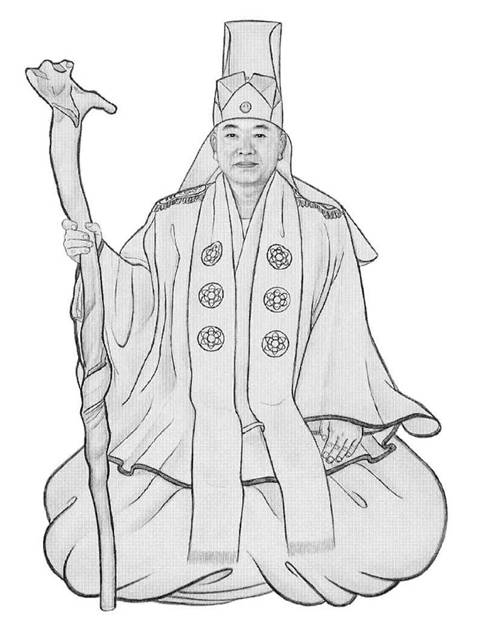
대원 문재현 / 大圓 文載賢 Daewon Moon Jae-hyeon (1936-)
(McCune-Reischauer:) Taewŏn Mun Chaehyŏn
(Magyar:) Tevon Mundzsehjon
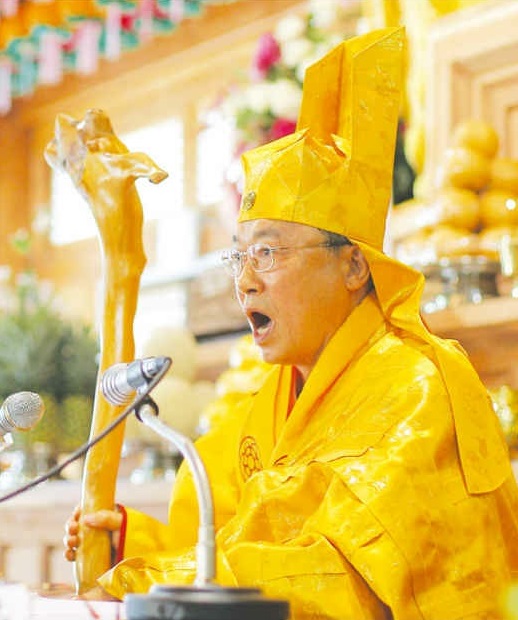
Master shouted out ”Ha!” during Dharma talk
![]()
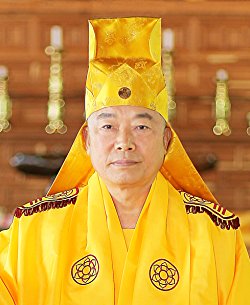
https://en.wikipedia.org/wiki/Daewon
https://archive.org/details/lineage_eng_ibooks
http://www.zenparadise.com/index.php/en/zen-master-daewon-moon-jaehyeon/
https://www.amazon.com/DaeWon/e/B0166MLEW8
PDF: Hwadu: Zen Questions and Answers from Korea
Written by Zen Master DaeWon Moon JaeHyeon
English translated by Eryn Michael Reager
Moonzen Press, Seoul, 2013 (Kindle Edition, 2015)
https://www.amazon.com/Hwadu-Zen-Questions-Answers-Korea-ebook/dp/B018S6GR68/
The Life of Zen Master DaeWon I to X
Dialogues with Zen Master SeungSahn 1 to 7
Hwadu 1 to 86
I. Birth
Stories of His Birth
Zen Master DaeWon was born in Korea in 1936. He was named Moon JaeHyeon by his parents Moon SiJung and Choe YunSim and was the youngest of two sons and three daughters. Korea was under Japanese colonial rule during this time and his father, Moon SiJung, also known as ORim geosa, was an activist in the Korean independence movement.
As a political fugitive of the Japanese regime, ORim took refuge at the Chilbul Hermitage and practiced there for the next six years. He returned home for a short while after six years of practice and it was during this stay that Master DaeWon was conceived. That night his mother had a dream that a dragon took her by the waist and flew up through the sky. Surprisingly, she neither felt fear nor discomfort but rather a feeling of comfort and joy.
II. Childhood
Only I Alone am Holy
When Zen Master DaeWon was a child, rice was so scarce due to frequent famine, people went out during the day to gather wild acorns to eat. So from the early age of five, he often had to pass the time alone. When sitting under the warm sunlight all by himself, he would play in the yard, drawing circles31) on the ground with his finger. As he drew the circle, the words “Only I alone am holy… Only I alone am holy…” would flow from his lips like lyrics of a song. Even though he would endlessly recite these words, he had no idea what they meant at the time.
Only until he learned the Dharma later in life did he come to know that the phrase, “In heaven and on earth, Only I alone am holy”32) was first said by the Buddha.
Beyond the Sky?
At the age of seven, Zen Master DaeWon began pondering, “As I stand here on the ground, the ground too must stand on something. Then that something must also stand on something else. And that on something else…” When he turned nine, the thought had developed into, “There must be a sky beyond the sky. Then there must be a sky beyond that sky, then a sky beyond that…” As the stream of thought continued, the sky, the ground, and even his body would disappear in an instant. Oblivious to the passing of time, he would be in nothing but the clear consciousness of complete emptiness itself.
After he realized the Dharma, he came to know that this was the stage of calm clarity of the boundless Self. But at the time he had no way of knowing or expressing the stage he had been in. When that thought arose, he entered into the state of samadhi and stood still for hours even on his way to school. Much later he would realize that it had become night and he had to return home. This happened several times.
One day he was alone with his father and sister as the rest of the family had gone to a family wedding. The next day his father told his children, “I will be leaving at midnight,” and had them prepare bath.
After taking a bath, he laid on a mat with young DaeWon and his sister at his side.
“Soon, I will leave this world,” he said, “something everyone must do at some point, so don’t be afraid or cry. Just watch carefully.” He told his children.
When the clock struck the foretold hour at midnight he instructed, “Watch carefully. This is how people leave.”
As soon as he uttered these words, his eyes rolled to the back of his head.
The children overwhelmed with fear, began beating his stomach and shouted, “If you must leave, please leave tomorrow afternoon when everyone returns home.”
Soon after he heard this crying, he revived himself.
“Are you that afraid?” he said. “Then I will leave tomorrow at noon. Let them know and have them return by then.”
Envisioned as he got up, he began writing about the world in the future. Exactly at noon the next day, he laid down his pen and entered nirvana as he had foretold. His father demonstrated freedom over life and death, entering nirvana in accordance with his own will.
31)In Buddhism, the circle represents Original Nature.
32)With one finger pointing at the sky and another finger pointing to the ground, Sakyamuni Buddha said, “In heaven and on earth, Only I Alone am holy.” This reveals the stage of enlightenment.
III. The Wandering Years
The Beginning - Why Does Man Live?
At the age of 18, the young DaeWon began searching for the answer to the question, “Why does man live?” Determined to not return until he found the answer, he left his home and set off to a lonely island. After buying the farthest one-way fare all his money could afford, he ended up on Bigeum island, an island strewn with vast yellow fields of barley. Here, he met a group of maidens on their way to pick herbs nearby Seosan Temple. And through meeting them, he came to know and stay with the Elder monk, Lee WolJe sunim33) at Seosan Temple.
At Seosan Temple
WolJe sunim was an exemplary monk of over sixty years who had spent most of his life practicing Zen at the Baegyang Temple. He told young DaeWon to memorize the sutras and perform Buddhist ceremonies if he wished to stay with him. When DaeWon refused, saying he didn’t want to memorize something he did not understand, WolJe sunim taught him the Prajnaparamita sutra.
When DaeWon heard the verse “Form is emptiness, emptiness is form”, he became one with the boundlessness he had experienced as a child - that state of being he could neither name nor express in words - and like the breath bursting open from suffocation, he began asking a barrage of questions.
Seeing this, the WolJe sunim said, “I have practiced Zen for over forty years but I cannot teach what you are looking for. You have many lifetimes of karma with the teachings and it would be good for you to study with Zen Master JeonGang of Naju Dabo Temple. He is well-known as a person who achieved the enlightenment at a young age, he is a truly great Zen Master whom I highly respect.”
The Elder’s Send-off
Shortly thereafter, young DaeWon went off to the mainland to meet Zen Master JeonGang at Dabo Temple, with a letter of introduction by the Elder Lee WolJe carefully tucked away at his breast.
As DaeWon boarded the ferry, WolJe sunim requested his teachings after he received the Dharma from Zen Master JeonGang.34) WolJe sunim sent him off, waving his handkerchief. As the ferry sailed farther and farther away from the island, he took off his white shirt and waved it until it grew smaller and smaller into a dot and went out of sight.
33)sunim : a buddhist monk/priest.
34)Enlightenment is the only way to be saved from the suffering of life and death so that is why Elder Monk Lee WolJe sunim asked Zen Master DaeWon to save him after he meets Zen Master JeonGang and receives the Dharma.
IV. Dabo Temple
“What is This?” Hwadu
When young DaeWon arrived at Dabo Temple, he could not find Zen Master JeonGang but met the abbot, Master Lee UHwa. He told him that Zen Master JeonGang only visits the Temple about once a year but gave him permission to stay there until the master returns.
Then one day, while standing outside the doors of the Dharma hall listening to the abbot’s Dharma lecture, young DaeWon heard the “What is this?” hwadu for the first time. The very moment he heard this, an intense reflection on the hwadu formed in him.
From this point on he would enter into samadhi unexpectedly, unaware of what was happening around him. However he did not understand this state he was in and so that was how he left behind many interesting and funny anecdotes at Dabo Temple.
Samadhi in the Bean Field
One day, as the only novice of Dabo Temple at the time, DaeWon was ordered to go out and weed the bean field. Absorbed in the “what is this” hwadu, he was unaware of the time passing by. Before he knew it, he had weeded an entire field. Unfortunately, he had not only pulled out the weeds but he had pulled out the bean stalks as well.
Around sunset, the abbot Lee UHwa began to wonder about the novice who had not returned since breakfast. After waiting impatiently, the abbot went to the field to look for the missing novice. But when he got there all he found was a bean field emptied of everything to its bare soil. He was so shocked that he began jumping up and down in an outrage. The abbot assumed that the novice was upset at having to work by himself and so was doing it intentionally. The young novice could not explain himself because he did not know what had happened while he was in the samadhi of the hwadu, in which there is a cessation of all thoughts and separation. He had no choice but to get down on his knees and beg the abbot to forgive him because staying at Dabo Temple was the only way for him to meet Zen Master JeonGang. He pleaded so sincerely, the abbot forgave him and let him stay a while longer.
Samadhi in the Sesame Field
The same thing happened again while young DaeWon was weeding the sesame field one day.
At first he had pushed aside the sesame and pulled out only the weeds. But soon, he entered samadhi with his hwadu and before he knew it he had weeded the field even of its sesame. Again, the abbot went to look for the novice. When he found the field empty with but a few remaining stalks of sesame in the corner, he was at a loss for words.
“Get out!” he said.
He was too dumfounded to show any anger. “Be gone! This is no place for a crooked novice like you. It’s no use for you to meet Zen Master JeonGang, he has no business with someone like you.”
Young DaeWon was so clueless. When he was asked why he did it, he could not say a word.
“I don’t know why I did it. I really didn’t mean to.” He replied with a dazed expression. He begged the abbot again to let him stay so he could have just one chance of meeting Zen Master JeonGang.
He begged with such earnestness that the abbot gave up and walked away saying, “Ugh! I don’t know what to do with you!”
That night, he had to go without dinner. By this time, rumors of the novice had spread throughout the entire temple that everyone at the temple began to stare at him and reproach him.
Samadhi at the Gyeonghyeon-ri Reservoir
The young novice DaeWon was able to endure the hard work and persecution at the temple solely with the determination to meet Zen Master JeonGang, but another incident happened one day before the memorial ceremony at the temple in remembrance of the veterans killed during the Korean War.
The novice was ordered to give a list of things needed for the ceremony to a devout Buddhist laywoman so she could buy the preparations at the market. While on his errand, he walked by the Gyeonghyeon-ri reservoir and spontaneously entered into samadhi upon hearing the sound of falling water.
Only being in the state of boundlessness itself - it is not like the brightness of the sun, nor like the brightness of the moon, neither like the brightness of fire - nothing but the stage of boundlessness, clearly aware of itself, and unaware of time.
When he awoke, it was already dark and without a single thought he returned to the temple.
As he entered the temple grounds, he saw the abbot and the community waiting impatiently. It was only then that he remembered the errand he was given that morning.
“Darn it!”
But it was too late.
“Did you get the things?” someone asked.
He was unable to reply.
“You fool!” said the abbot, “What were you up to? What were you doing all this time?”
He answered, “I was sitting by the Gyeonghyeon-ri reservoir.”
“What were you doing there?”
“Nothing.”
“You rascal! Somebody ought to teach you a lesson.”
But without any time to punish him, the abbot had to run to the laywoman’s house, gather as many helping hands as he could, and had them buy the preparations first thing in the morning. The entire temple was in a rush as everyone scurried to prepare for the ceremony. But even then the foods were prepared too late and the ceremony could not be held on time.
From then on, the people at the temple began to lose their patience with the novice.
“Get out of my sight!” they would say. He no longer was sent on any more errands.
When the laywomen of the temple confronted him about what he had been up to that day, he could only lower his head and reply, “I was at the reservoir.”
“Go away,” they said. “You are worthless!”
He could no longer beg to stay at the Dabo Temple. Tears began to fall from the his eyes at how ridiculous and frustrating the situation had become.
“I know I did wrong.” he pleaded, “But I really don’t know why I did it. I will leave if you tell me to but please don’t think that I did those things on purpose. The day will come when I meet Zen Master JeonGang and I don’t want him to think poorly of me. I swear on the Buddha that I didn’t do it on purpose or with bad intention.”
At the sight of the novice pleading in tears, the abbot said that since Zen Master JeonGang was coming soon he could stay a bit longer.
Samadhi while Steaming Soy Beans
After the incident at the reservoir, the climactic event occurred while he was steaming soy beans to make meju.35)
But this incident served to clear the misunderstanding the abbot and the others at the temple had about the novice.
It was early winter and he was sitting by the furnace, steaming soy beans when he entered again into the state of samadhi. He packed the furnace with wood and went into a small room next to the furnace. He sat there in boundless being itself, unaware of time passing.
No one knows how much time had passed. Then, he heard a faint sound. At first, it was as small as the sound of an ant. Then as the sound grew into what sounded like muffled explosions, he vaguely realized it was the sound of a staff banging against the floor.
“Open up! You are going to get what’s coming to you.” The abbot shouted loudly, but he had no idea why the abbot was mad. It turned out that the pot of soy beans sitting on the furnace had burned into chunks of coal.
The abbot ran into the room where he was sitting and grabbed the novice by the collar. But suddenly the abbot rushed out of the room, leaving the novice behind. From outside the door he called quietly, “Come out here. Who are you?”
Novice DaeWon slowly crawled out of the room at the sound of the abbot’s voice. As soon as he was out the abbot quickly pulled down his trousers without a word of warning.
“Huh… Nothing.” said the abbot, examining the novice’s bare skin. “Show me your ankles.” To the abbot’s surprise, he was fine. “Look at him.” the abbot said, astonished. “He’s unscathed. Unbelievable.”
“What were you doing in there?” asked the abbot.
“Nothing,” he replied.
“What were you thinking?”
As the abbot inquired in greater detail, the young novice was finally able to explain himself. “When you were giving a Dharma lecture,” He began, “I heard you speak on the hwadu, ’What is this?’ I became like this after hearing the hwadu.”
“Aha! Is that what happened when you were out in the bean field?”
“Yes.”
“And in the sesame field?”
“Yes.”
“Were you like this when you were by the Gyeonghyeon-ri reservoir?”
“Yes.”
“Were you like this sitting here in this room just now?”
“Yes.”
Hearing this, the surprised abbot said, “Why didn’t you tell me? You would have avoided all those problems had you told us. From now on you can practice all you want. No one will make you do any errands. You can sleep and eat at the Yeongsan-gak. I’ll even clean up after you. Now you can practice as you wish.”
What had changed the course of events was the moment the abbot walked into the room the novice DaeWon was sitting in; the room was so hot, like a boiling cauldron, that he had to run out to stop his feet from burning. The sight of the novice sitting still on that smoldering floor had surely surprised the abbot. Moreover, seeing there wasn’t a single burn on the novice’s body, the abbot thought that he was under the providence of the Buddha. The floor of the room was burnt coal black from this incident.
The Mute Novice
From that day on, novice DaeWon practiced at the Yeongsan-gak, devoting himself to silent yongmaeng jeongjin,36) and eating only one meal a day. Everyone started calling him “the mute” and treated him as if he were someone else.
Sitting in silence without food for a whole day would make his lips chap and stick together so that he had to go down to the brook and wash his lips before taking his meals.
And so he passed his time practicing like this, but still Zen Master JeonGang didn’t show up.
35)meju : square blocks of steamed beans used to make traditional Korean soybean paste.
36)yongmaeng jeongjin : intense practice with resolute determination and a specific purpose during a set period of time.
V. Ordination
Ordination by Zen Master Bak InGok
One day, a monk named PoGong sunim came to take the novice to Zen Master Bak InGok of Haein Temple so he could receive the precepts and become ordained.
Zen Master Bak InGok was a benevolent man with a spirit free from any intent to harm or kill. While walking in the woods, animals would approach him to lick his hands and rub themselves against him. He was not only a benevolent man, but also a great Zen master who had attained mastery of his own life and death. Like ORim geosa, DaeWon’s father, Zen Master Bak InGok had planned to enter nirvana at midnight but delayed the time of his death to noon the next day at the request of his disciple.
He had foretold the day and hour of his death a week in advance, and exactly on the foretold hour he entered nirvana in Toeseoldang of Haein Temple surrounded by his eighty pupils. Among the pupils that had gathered from across the nation was the aforementioned PoGong sunim.
Though a monk, PoGong sunim had little interest in the practice of Zen, for which he was often reprimanded by his master. Nonetheless, no one exceeded PoGong sunim’s love and piety for Zen Master Bak InGok. Whenever he would find anything good while traveling throughout the country, he would always bring them to his master.
So when Zen Master Bak InGok was about to enter nirvana, PoGong sunim began crying and making a scene. In order to delay the hour of his death, PoGong sunim said that one of Zen Master Bak InGok’s disciples was late on his way and hadn’t arrived yet.
“You are no master! If you are a true master you should wait for all your disciples. Why must you leave now?” He cried, beating his fists to the floor. Hearing PoGong sunim cry like a child having lost its parents, Zen Master Bak InGok revived himself and said, “Must you be like this when it is my time to go? Then I will leave tomorrow. Tell them and make sure everyone is here by then.” He then gave a Dharma lecture on the Sinsimmyeong. The next day, he entered nirvana.
Zen Master Bak InGok was no ordinary Zen Master; however, even his Dharma teachings did not fully satisfy DaeWon sunim’s heart.
100 Sleepless Days of Yongmaeng jeongjin
During retreat periods DaeWon sunim searched for all the renowned Zen Masters throughout the country and studied under them, and after the retreats, he would return to serve Zen Master Bak InGok.
DaeWon sunim heard eighty of the nation’s most renowned Zen monks would be gathering in Beob-wang Temple in Chilseong Mountain of Gangwon Province to hold a Zen meditation retreat and he decided to join. The retreat was to be a hundred days of yongmaeng jeongjin, in which the monks would practice sitting meditation without sleep under the watch of six monitors taking rotating shifts.
In the beginning of the retreat, all the monks were brimming with determination, even prepared to meet death, but not sleeping for one hundred days is easier said than done. After a few days, one of the monks sitting in the meditation hall suddenly got up, walked by the door, and jumped out of the window onto the snow-covered garden. Then with an imaginary rake in one hand, he pretended to weed grass that wasn’t even there. When asked what he was doing, he said he was weeding the grass.
Not only that, some of the sleep-deprived monks began to behave in bizarre, unimaginable ways. When laid to rest in a heated room, these monks slept for days without waking or eating. Only after a period of full rest did they return to their normal selves.
It is not easy to complete one hundred days of meditation without sleep, but they practiced with the will and determination to transcend life and death. At times DaeWon sunim would sit on a frozen stream to keep himself from falling asleep.
By the end of the retreat, only two of the eighty participants were left, one of which was Hyeam sunim, who would later become the head of the Jogye Order. The other was DaeWon sunim.
After the hundred days of yongmaeng jeongjin, TanHeo sunim gave a Dharma talk. As he got up on the Dharma rostrum, DaeWon sunim said, “Sunim! The magpie over the stream has already finished the Dharma talk.” To this, TanHeo sunim turned around and came down from the Dharma rostrum.
VI. Enlightenment
Song of Enlightenment
Some time after the end of the hundred days retreat, Master DaeWon effortlessly composed his first Song of Enlightenment while practicing yongmaeng jeongjin alone at Dosol Hermitage, to the sound of wind passing through the pine trees.
What is this thing that carries this body?
On the third or fourth year I had contemplated thus,
To the sound of the wind swishing through the pine trees,
The great work was completed all at once.What is sky and what is earth?
This mind, as it is pure, is boundless, just like this.
Responding, just like this, where there is no inside or outside,
There is originally nothing gained nor lost.Is there anyone who can believe without a doubt?
All thoughts, knowing and distinguishing,
Over which we spend our day;
This is the mysterious awakening even before the ancient Buddha!
After reciting the Song of Enlightenment, DaeWon sunim exclaimed, “You of yesterday is not the I of today but I of today is the you of yesterday.”
Then another song sprang from his lips:
Illusion is destroyed by illusion,
Being destroyed, there is no destruction!
Three times three reversed is still nine.
While passing the field of Gimje, he composed his second Song of Enlightenment:
The sun in the west and the moon in the east, lightly hang over the mountains,
And the fields of Gimje are filled with the autumn hue.
Even though the whole universe cannot be,
People come and go on the road with the setting sun.
Dharma Conversation with Zen Master GyeongBong
Even after enlightenment, Zen Master DaeWon’s desire to meet Zen Master JeonGang was so strong that he began asking everyone he met where he might find the Zen Master. But Zen Master JeonGang was a wanderer who never stayed in one place for a long time, so no one knew where he was.
Then one day, a traveling monk mentioned that at the Geungrak Hermitage in Tongdo Temple is a Zen Master named GyeongBong sunim who had received in-ga37) from Zen Master JeonGang and that their Dharma teachings would not be so different. So DaeWon sunim headed toward Geungrak Hermitage of Tongdo Temple to meet Zen Master GyeongBong.
It was around late fall when the Zen Master arrived at the Tongdo Temple and saw Zen Master GyeongBong picking persimmons with a bamboo stick in the front garden. Upon seeing the Zen Master GyeongBong, he circled the persimmon tree once, observed the proper formalities, and stood before him. Zen Master GyeongBong finally asked,
“Where are you from?”
“I am from Honam,” replied DaeWon sunim.
“What have you practiced?”
“I’ve practiced Zen.”
“What is Zen?”
(At this moment, Zen Master GyeongBong was pulling off a persimmon from the end of the bamboo stick.)
“The persimmon is red,” answered DaeWon sunim.
“Do you know the Dharma?”
“If it is known, it is not the Dharma.”
Zen Master GyeongBong, who had not laid eyes upon his visitor until he heard these words, finally looked at DaeWon sunim. Then without saying anything, he returned to what he was doing. Right there the stage of Zen Master GyeongBong was revealed and his teachings did not fully satisfy DaeWon sunim.
From his meeting with Zen Master GyeongBong until his meeting with Zen Master JeonGang, Zen Master DaeWon met with Zen Master Ha DongSan, Zen Master GoBong, Zen Master SeolBong, Zen Master GeumBong, Zen Master HyoBong, Zen Master GeumO, Zen Master ChunSeong, Zen Master CheongDam, and others in order to test the stage of their enlightenment, and responded impeccably to all their questions. However, none of their Dharma teachings fully satisfied his heart.
Finally, he came to meet Zen Master JeonGang at a place he had least expected.
37)in-ga : the formal recognition of a disciple’s enlightenment by a master who has mastered all truths.
VII. With Zen Master JeonGang
First Meeting with Zen Master JeonGang
In Gwangju City there was a temple called Donggwang Temple that was used as an administrative office for Jogye Order. After the summer monastic retreat,38) Master DaeWon was wandering as a way of practice and while stopping by the Donggwang Temple, he went to the Dharma hall to give obeisance to the Buddha.
As he was about to enter, he saw Zen Master JeonGang open the Japanese styled sliding doors of the Dharma hall and fan himself while leaning against the entrance.
He was sitting by himself, resting and cooling off from the summer heat just after finishing a Dharma lecture on Bodhidharma’s “I don’t know” kong-an.39)
Remarkably, although it was his first time seeing him, Zen Master DaeWon immediately recognized Zen Master JeonGang. Without hesitation, Zen Master JeonGang asked DaeWon sunim, who was but a monk in his early twenties, about the “I don’t know” kong-an. This is how Zen Master DaeWon finally met the master he had been so desperately trying to find.
Zen Master JeonGang said, “Today, I gave a Dharma talk on the “I don’t know” kong-an but nobody answered. How would you answer?”
In response to his question, DaeWon sunim approached him without a word and pulled out a long hair from a black mole on the left side of his neck.
“There’s a murderer here!” He shouted loudly and followed as DaeWon sunim walked towards the dormitory. By the time DaeWon sunim entered the administrative office, Zen Master JeonGang had returned to the Dharma hall. Zen Master JeonGang’s attendant, SongDam sunim was in the office at this time.
As DaeWon sunim left the temple and Zen Master JeonGang and SongDam sunim walked him to the outside of the temple gates. Patting his back, Zen Master JeonGang said, “If we part now, when will we see each other again? We must meet again. There will come the day.” Zen Master JeonGang gave the DaeWon sunim 500 won to spend on his fare.
DaeWon sunim refused but Zen Master JeonGang insisted, “You must take this money I give you.” and put the note in his hand.
Together Again with Zen Master JeonGang at Eunjeok Temple
DaeWon sunim wandered about as a way of practice; but when he found out that Zen Master JeonGang, who was well-known for refusing the title of abbot at any temple, became the abbot at the Eunjeok Temple in Gunsan, he served the Master for a period in autumn.
Eunjeok Temple was seated in the middle of a vast field, surrounded by many large rice paddies. Behind the temple lay a small mountain and before it, a stream of fresh spring water gushed forth.
At the time, Zen Master JeonGang had three disciples - JeongDae, JeongCheol, and DaeWon. Zen Master JeonGang’s teaching methods were very strict and harsh. Zen masters are truly without pity but in fact, there is always a reason behind their behavior. Since Zen Master JeonGang was a very strict teacher, he had only a few visitors and followers despite the fact that he was a great Zen master.
The three disciples spent their days harvesting the fields of Eunjeok Temple and moving the harvest by a rickshaw. They would work so hard that they had to take two to three baths a day to wash off the sweat. After a full day of work and performing rites, sleep would finally set in.
Right then, however, Zen Master JeonGang would lift himself up onto the rostrum with his staff and begin lecturing on the Dharma while the three disciples kneeled on the hard, bumpy floor.
While the other disciples, with their bodies tired from a full day’s work and enduring the pain in their knees they began to doze off. At times they even toppled to the side. But DaeWon sunim couldn’t possibly fall asleep because listening to the master’s Dharma talk resonated with him and sent shivers down to the marrow of his bones.
As the two disciples dozed off, Zen Master JeonGang would strike the podium and shout, “You fools! Would you fall asleep if you were being pushed into the fiery pits of hell? How dare you sleep through something as important as this?” He was fierce enough to make the heavens shudder.
But it was to no avail.
“Yes master, we’re awake. We won’t fall asleep again.”
But after they said these words they would again drop their heads.
Nevertheless, none of them held a single complaint against their master.
By day they would work, carrying sheaves of rice under the scorching sun and by night, they would listen to Dharma lectures with disciplinary rebukes.
“You fools! Everyone used to beg me to go sleep whenever I practiced. They begged me to stop. But I didn’t. No one else would help you study like this. You can search high and low! Who would ever give you such Dharma lectures every night? And you have the nerve to sleep through it?” It wasn’t strange that he would scold them so fiercely because as a pupil, he had practiced too hard, to the extent that the blood vessels in his head ruptured.40)
Then one day, after taking a bath at a spring nearby, DaeWon sunim ran into Zen Master JeonGang on his way back to the temple. At this moment, the following conversation took place:
“Tell me about the spiritual awakening in the silent void?” Zen Master JeonGang asked.
“Just like this, I talk with you.”
“Tell me about the silent void in spiritual awakening?”
“Talking with you, I am just like this.”
As DaeWon sunim answered, Zen Master JeonGang gave him a sharp stare and asked, “What is the stage of talking ‘just like this’?”
He asked, to test whether his student truly knew the stage of being “just like this”.
“A wise king wholly responds to everything without leaving his throne.”
As DaeWon sunim gave his answer, Zen Master JeonGang’s face lit up and he walked away contentedly nodding his head.
By the end of the season, all the harvest was stored and the work was completed. Now that DaeWon sunim had shared the Dharma with Zen Master JeonGang he left Eunjeok Temple, keeping the promise to not stay in one place for more than three months.
38)The summer monastic retreat and the winter monastic retreat are the three-month periods in the summer and winter when Buddhist monks live and focus on their Zen practice together in a certain place.
39)Bodhidharma’s “I don’t know” kong-an : Bodhidharma was a prince of the Pallava Dynasty in ancient India who received the Teachings of the Prajnatara after being ordained. Realizing the many opportunities for spreading the Dharma in the east, he sailed to the Liang Dynasty. When he heard that the Emperor Wu of Liang was a devout Buddhist who had built a thousand Buddhist pagodas and statues throughout his land, Bodhidharma paid him a visit. Before the Bodhidharma, Emperor Wu Liang asked,
“Since I’ve become emperor, I have built many temples, issued various sutras, and ordained numerous monks. What then, is my merit?”
“There is no merit.”
“How is there no merit?”
“It is merely the cause of being born into the world of man and the world of heaven. Like the shadow that follows its object, it is not real.”
“What is the foremost teaching of the Dharma?”
“Being boundless, just like this, there is nothing to call a saint.”
“Who, then, is the one facing me now?”
“I don’t know.”
The Emperor Wu stood in confusion and Bodhidharma crossed the Yangtze River and went to the Wei Dynasty.
40)When Zen Master JeonGang was a practicing monk, he would concentrate so hard on hwadu a concentration of energy would rise up in his body and rupture the blood vessels in his head. Doctors had given up, saying that it could not be treated with medicine. Eventually he attained enlightenment and survived through the power of samadhi.
VIII. In-ga
Dialogue on the Mountain at Donghwa Temple
In 1962 Zen Master DaeWon went to the Geumdang Zen Center of Donghwa Temple to take part in the summer monastic retreat. The abbot of the temple, WolSan sunim had publicly announced that Zen Master JeonGang would be overseeing the retreat and many people gathered there to practice under him.
It was an evening session of sitting meditation but the seats in the meditation hall were empty except for those of a couple elder monks.
As Master DaeWon was thinking this to be unusual, he saw a young monk furtively call him out, quietly waving at him from outside the hall. When he went to him, the young monk told DaeWon sunim that a group of monks were waiting for him up on the mountain out back.
DaeWon sunim followed the young monk into the mountain and found a gathering of twenty monks, waiting for him in stony silence. Immediately upon seeing DaeWon sunim, one of the monks named BeopSeong (also known as Zen Master JinJe, a disciple of Zen Master HyangGok) called out to him,
“Speak on the Bodhidharma’s ‘I don’t know’ kong-an.”
DaeWon sunim answered without a moment’s hesitation,
“Revealed.”
SongAm sunim, who was standing nearby asked him about the Ansujeongdeung kong-an,41)
“How would you save yourself?”
DaeWon sunim spoke loudly,
“An! Su! Jeong! Deung!”
All the gathered monks stood still with their lips pursed in silence as DaeWon sunim turned around and walked away.
The next day after breakfast, MyeongHeo sunim, who was serving as monitor for the retreat, called a temple hearing to find out why the monks had been absent without notice the night before. During the hearing, all that had happened up on the mountain was laid out in the open and as a result, the monks who had been absent during the sitting meditation session assumed their formal robes and bowed in penance before Zen Master JeonGang, who was serving as the Josil42) of the temple at the time.
In-ga by Zen Master JeonGang
The next day, Zen Master JeonGang called on DaeWon sunim. He told him that his first Song of Enlightenment was clear evidence of his enlightenment but that a Song of Enlightenment is customarily kept short.
To this, DaeWon sunim recited the second Song of Enlightenment he had composed when he saw the sun and the moon in the setting sky while passing the fields of Gimje.
After Zen Master JeonGang heard the second Song of Enlightenment, he again asked Master DaeWon to make up another song on the spot that would encapsulate the same stage of enlightenment.
Immediately upon this request, Master DaeWon produced the following song:
Over the rock the wind passes through the pine trees,
And below the mountain flies the golden oriole.
There is not a trace even of the entire universe,
But the monkey cries loudly under the moonlight.Zen Master JeonGang listened to the first two lines with his eyes gently closed; then upon hearing the last two lines, he opened his eyes, revealing delight. However, he didn’t stop there and asked once more, “When the others called you out on the mountain and BeopSeong asked you to speak on the ‘I don’t know’ kong-an, you said, ‘Revealed.’ If you were Emperor Wu of Liang, how would you respond to Bodhidharma’s ‘I don’t know’?”
“If I was Emperor Wu of Liang, I’d respond by saying ‘Even though there is no such thing as a saint, wouldn’t it be much better to enjoy the flowering of my virtue together, just like this?’ and take him by the hand.”
Zen Master JeonGang spoke with astonishment, “How have you reached such a stage?”
“How could one say that he has reached it, that he has it, or that it is of his nature? It is only just like this.”
As DaeWon sunim continued, Zen Master JeonGang became greatly pleased and the two came together like BaegA and JongJaGi.43)
The day after this thorough test of his enlightenment Zen Master JeonGang called to Master DaeWon. When he arrived, he found Zen Master JeonGang with the abbot, WolSan sunim, who had been asked to be a witness.
There Zen Master JeonGang gave him the following song of Dharma transmission:
Even the Buddha and the patriarchs had transmitted nothing,
How could I say I have received it or will give it.
This Dharma, in the 21st century,
Will be a refuge for all in this world.Zen Master JeonGang appointed WolSan sunim to be witness of this in-ga, Dharma transmission, so that no one else should know of this before the year 2000.
He forewarned that if not, it would bring many obstacles to Zen Master DaeWon in opening the way for his teachings and cautioned them to keep an eye out for his safety.
Then, Zen Master JeonGang ordered WolSan sunim to send Zen Master DaeWon to Bohyeon Temple, an ancillary temple of Donghwa Temple, so that he could teach the Dharma to lay people.
The day Zen Master DaeWon left for Bohyeon Temple, Zen Master JeonGang walked with him a mile outside the temple gates and gave him a piece of paper with a song he had written for his parting disciple.
To respond just like this without leaving his throne,44)
In days to come a child of stone will blow a flute without holes.
Thenceforth, the Dharma will spread throughout heaven and earth.
Teaching the Dharma at Bohyeon Temple / Zen Master JeonGang Visits
By order of Zen Master JeonGang, Zen Master DaeWon left Donghwa Temple before the end of the summer retreat and began holding public Zen meditation sessions at Bohyeon Temple. He also began giving Dharma lectures on the Diamond sutra to the attending laity.
Whenever Zen Master JeonGang had the chance, he would visit Bohyeon Temple, sit quietly at the back of the Dharma hall, and listen to Zen Master DaeWon speak on the Diamond sutra.
After the lecture, Zen Master JeonGang would pat Zen Master DaeWon’s back and generously commend him. “People have said that the greatest speaker on the Dharma is Ha DongSan but I’m truly impressed by your Dharma teaching. How do you speak so perfectly on the Diamond sutra - no more, no less - and still make it easy for people to understand? I knew you were different when you answered so impeccably at Eunjeok Temple. When you finish speaking on the Diamond sutra, you must publish it so that many people can read it.”
But in 1962 the reformed Jogye Order designated Donghwa Temple to be the place of residence for the head of the Order, Zen Master HyoBong. So Zen Master JeonGang and WolSan sunim left Donghwa Temple before Master DaeWon could finish speaking on the Diamond sutra.
Collective In-ga on the Diamond Sutra
When Zen Master DaeWon’s teachings on the Diamond Sutra at Bohyeon Temple were published, it stirred up a great controversy in Korean Buddhism. It was a novel and extraordinary text with categorized passages and each passage including a song and a commentary, but the controversy had to do with the translation of an important passage that was different from previous Zen Master’s translations.
In the Diamond sutra there is this passage:
“Subhuti, what do you think? Can you recognize the Tathagata45) by body or by form?”
“No, World Honored One, it is impossible to recognize the Tathagata by body or by form. This is because you have taught us that phenomenal characteristics are not really such. ‘Body and form’ is merely a name, and not true body and form.”
“Subhuti, all forms are delusions. If you can see that all forms are in fact not forms, then you can correctly see the Tathagata.”
Where previously Masters had written, “All forms are delusion.” Zen Master DaeWon had translated it as “Though it is said that all forms are delusion.”
It seems as if this is a minor detail, but in fact there is a very important difference, and Master DaeWon explained:
“To say ‘All forms are delusions’ makes the meaning of passage inconsistent. Earlier in the passage Subhuti confirms that, ‘Body and form is merely a name, and not true body and form.’ If form is in fact ‘not form’ then how can form be called delusive? As the sutra mentions, since Buddha taught Subhuti that form is not substantial, but merely a name, then there is also nothing to be called ‘form’ or ‘delusion.’ So to be exact it should be translated, ‘Though it is said that all forms are delusions’.”
This newly translated passage received much attention and so it was inspected by Zen Master Ha DongSan, Zen Master GeumO, Zen Master CheongDam, Zen Master ChunSeong and other Zen masters, all who had received in-ga transmission from Zen Master ManGong and Zen Master YongSeong.
The arbiters confirmed Zen Master DaeWon’s translation as a more accurate transcription that better reveals the Dharma.
Also, through the meeting Zen Master DaeWon’s enlightenment was examined and certified by all the higher Zen masters.
41)Ansujeongdeung kong-an : A man being chased by a rabid elephant fell into a well. At the bottom of the well were four poisonous snakes waiting to devour him. Before falling to the bottom of the well, he grabbed hold of a vine being gnawed at by white and black mice. With the rabid elephant thumping outside, there was nowhere for him to run. At this moment, a drop of honey fell from a beehive hanging above into the poor man’s mouth. At the taste of honey, he forgot all the danger he was in. The question of how one would save one’s self in this situation is the kong-an of Ansujeongdeung.
42)Josil (祖室) : The highest authority on the Dharma in a temple. The Great Zen Master JeonGang was also a patriarch who had received the Dharma of enlightenment directly descended from the Buddha.
43)BaegA was the master of the geomungo, a 6-stringed zither, in ancient China. Although he was the greatest player of the geomungo in all of China, only his most beloved friend, JongJaGi, could truly understand and appreciate his music. So when JongJaGi suddenly passed away one day, BaegA smashed the geomungo and cut its strings, never to play again.
44)The first line of the gatha “To respond just like this without leaving his throne” refers to the Dharma conversation between Master DaeWon and Master JeonGang at Eunjeok Temple.
45)Tathagata: in Sanskrit literally “Thus-come”.
IX. The Hermitage Years
From Buddhist Reformation to 20 years of Borim
Thereafter, Zen Master DaeWon voiced the need for reform in Buddhist practices, advocating the foundation of broadcasting networks and hospitals, as well as the reform of Buddhist robes. All the elder monks opposed saying he would deplete the treasury of the Buddhist Order.
However, the Supreme Patriarch of the Jogye Order, Zen Master Ha DongSan and the Order’s Executive Director of Administration, Zen Master Lee CheongDam agreed saying, “You have foresight. But it’s not the right time as we have just undergone the Purification Movement46) of the Order.”
Strongly determined to bring about the reform even if he had to do it all by himself, Zen Master DaeWon began to concentrate on ways of raising funds, which the two elders approved and supported. In the course of his efforts, Zen Master DaeWon set aside 30 years for borim and lived as a layman without teaching the Dharma and hiding his identity.
Return to the Path of Teaching the Dharma
Zen Master DaeWon’s return to the path of teaching the Dharma was marked by a strange incident. One day in 1986, Zen Master DaeWon was sitting in a teahouse in front of the Jogye Temple in Insa-dong, when a middle-aged man came in with a group of men, all together prostrated themselves before him, and bowed three times on the teahouse floor. It turned out that the man, a professor of Hong-ik University, had a dream the previous night where the Bodhisattva Avalokitesvara47) appeared and showed Zen Master DaeWon to him. The dream had been so vivid that he called on a group of his students and went with them to the place he had dreamt, only to find the Zen Master sitting as the Bodhisattva had revealed to him. Overcome with astonishment, the professor and his students couldn’t help but bow before the Zen Master though they were meeting him for the first time.
After a series of such incidents, the decisive event occurred when the elder DoRyun sunim, having gathered fifty of the community’s leaders to organize a Zen fellowship, invited Zen Master DaeWon to sit as Jidobeopsa48) for the fellowship.
Unable to refuse the request of the elderly monk, Zen Master DaeWon decided to shorten the thirty years of borim he had originally set to a period of twenty years and walked the path of teaching once more.
46)Purification Movement : During the Japanese occupation of Korea, the Japanese administration forced the Buddhist monks to marry as an attempt to exterminate the morale of the Korean people. Monks who were not married were not permitted to take abbacy at any temple. This was carried out with the intent to tie them to their families and keep them from participating in the independence movement. After the end of the Japanese occupation, a system of purification took place in which the married monks were driven out of the temples and replaced by the unmarried monks.
47)Bodhisattva of Compassion.
48)Jidobeopsa : a teacher who gives Dharma lectures at a retreat.
X. Teaching the Dharma
Giving Condolence to Zen Master WolSan
Since embarking on the path of teaching, the efforts of Zen Master DaeWon have been steps to manifest the Dharma throughout the world.
In September 1997, Zen Master WolSan, who had stood as witness to Zen Master DaeWon’s in-ga transmission, entered nirvana while in office as the Josil of Bulguk Temple. For this occasion, Zen Master DaeWon went down to Bulguk Temple to deliver a special eulogy for the late Zen Master WolSan.
Although there was a significant age difference between the two (Zen Master WolSan was twenty-three years his senior), they were friends in the dharma.
Befitting the seniority of Zen Master WolSan in the Buddhist Order, all twenty elders of the Order were present for the eulogy.
After entering with a procession of followers, Zen Master DaeWon, without prostrating,49) stood erect and said, “Zen Master WolSan, it is DaeWon. I have prepared a song to read for this occasion. And I ask all of you gathered here: Where is Zen Master WolSan now?”
Then Zen Master DaeWon recited the following song:
Where lies the entrance to the path of nirvana?
It is the fresh green pine tree in front of the Dabo Pagoda.
Just like this, every object is one with the Original Mind.
It is heaven by nature, just like this.If not… (He claps his hands once)
And, in life, as their hearts were close in the Dharma, this eulogy expressed this relationship.
Even before leaving the memorial, he did not bow but said, “Where is the house of mourning?” Many people were taking part in Zen Master WolSan’s cremation ceremony and it was just after this ceremony when the following Dharma conversation was shared impromptu between Zen Master DaeWon and HwalAn sunim. As Zen Master DaeWon was leaving the ceremony, HwalAn sunim asked,
“Come here. Why do you look so worn out?”
“Why do you see only my worn out face?” responded Zen Master DaeWon.
“How old are you now?” HwalAn sunim asked again.
“Eighty-one.”50)
“Eighteen?”
Zen Master DaeWon tapped the HwalAn sunim’s forehead with his fingers three times and said, “Nine times nine is eighty-one.”
Visits to Buddhist Zen Temples in China
In 2003 and 2005 Master DaeWon traveled to China to visit the Zen temples of the first through the sixth patriarch and other famous temples. At the Shaolin Temple, Zen Master DaeWon had a Dharma conversation with the Josil of the Temple, Seok YeongSin sunim. When Zen Master DaeWon asked, “Here, I have seen the essence of the Shaolin martial arts. But what is the essence of Zen in the Shaolin Temple?” The Josil answered at length, “Each and every person has different karmic relations and affinities for good and evil. Therefore, it is difficult to summarize and say in one word.”
Zen Master DaeWon asked once more, “Then you ask me what is the essence of Zen in the Shaolin Temple.”
“What is the essence of Zen in the Shaolin Temple?” the Josil asked without the help of the interpreter.
“Hak!” Zen Master DaeWon answered with a thunderous shout.
The Josil said nothing. Zen Master DaeWon then extended his hand out to the Josil, shook his hand, and walked out of the Shaolin Temple.
The Un-geo Temple had once been the home of HeoUn sunim, the most revered monk in all of China. Surrounded by beautiful mountains and landscapes, the temple was vibrant with the energy and scent of living Dharma. When Zen Master DaeWon and his followers arrived, the Josil of the temple was absent so they met and had a Dharma conversation with DaeHye sunim,
“Zen is internal and interactions of the external come from within. There is only one Zen. It is not two.”
Zen Master DaeWon asked, “What would you do if I asked you to speak on this one Zen in one word?”
The monk raised his hand and laid it on the table.
“Wouldn’t it be fitting to give my own response?” Zen Master DaeWon replied. “If I were to answer, I would say that the ginkgo tree over there has answered before me. I will ask you one more thing. Many people in China chant the Amita-Buddha mantra. Two people, each on their way to meet the Amita-Buddha to gain freedom from life and death, meet in the middle of a narrow bridge. What should one do in such a situation?”
“I will answer when I meet him myself.”
At that moment Zen Master DaeWon shouted, “Hak!”
Hearing this, DaeHye sunim bowed his head and said it was a great honor to meet Zen Master DaeWon.
DaeHye sunim, though in worn out robes, was one of the few monks in China who emanated the force of Zen practice, in his calm expression and demeanor, and in his taciturn and firm tone of voice.
At the Mannyeon Temple in Ami Mountain, after hearing that the temple was a sanctuary of the Samantabhadra, Zen Master DaeWon asked, “Have you seen the Samantabhadra?”
“One may see the Samantabhadra if he tries hard with diligent practice and good deeds,” replied the Josil of the temple.
“Ask me if I have met the Samantabhadra,” Zen Master DaeWon said.
“Have you met Samantabhadra?”
“I meet him in the running stream and green forest.”
“In the eyes of a Zen master, all beings are the Buddha, but in the eyes of sentient beings, even the Buddha is a sentient being,” the Josil replied.
Present Day Activities
Zen Master DaeWon is currently the head of the International Jeongmaek Zen Foundation and holds monthly Dharma lectures in Jeongmaek Zen Centers throughout Korea, including Seoul, Busan, Pocheon, and Gwangju. He also spends much of his efforts training his disciples and teaching lay people on the Dharma.
Moreover, he has translated and published several sutras including the Heart sutra and the Diamond sutra, as well as numerous ancient Zen texts such as, “Transmission of the Lamp”, “Seonmunyeomsong”, “The Blue Cliff records”, and “The Gateless Gate”.
He has published a total of fifty works through Baroboin Publications and has completed over a hundred manuscripts of sutras and Zen texts.
Not only does he directly oversee the continuous construction of temples, but he has also been passionately working to find solutions for various global environmental issues we face today.
Desertification is one of the major environmental problems we are facing in the world today and so the Master has established a coalition to combat desertification in Korea.
Besides desertification, this coalition promotes the development of alternative energy and restoration of grasslands.
A few global interest groups however, cannot solve all the problems. The Master emphasizes that everybody including governments and organizations must take a part in working together, with wisdom, in order to find a solution. If we all work together and focus our efforts on these problems then we can make a good world. However if we continue to behave as if this is somebody else’s problem then we will not be able to avoid a global crisis.
It is the Master’s belief that the meaning of Buddhism is not simply propagation of the Dharma. All together we must help, both materially and spiritually, until we all have eternal happiness.
49)When offering condolences at a funeral in Korea, it is customary to prostrate before the deceased and the chief mourner. However, because Zen Master DaeWon was one who had realized there is inherently no life and death, he did not consider the occasion a funeral service. This is why he did not prostrate himself.
50)Zen Master DaeWon was 61 at the time.
Dialogues with Zen Master SeungSahn 1 to 7
Dialogue with Zen Master SeungSahn 1
Zen Master DaeWon met Zen Master SeungSahn at the ceremony to celebrate the completion of Guryong Temple in the summer of 1989. The excerpts below are taken from a long conversation over the Dharma that they shared. Outside their room, shouting, slapping, the thudding of thrown objects, and finally loud laughter could be heard. Others who were waiting to see Zen Master SeungSahn wondered at what was going on inside. When the door opened, Zen Master SeungSahn called in those who accompanied Zen Master DaeWon and told them, “You are truly blessed to have a great teacher like Zen Master DaeWon, I hope you all practice well.”
SeungSahn : Tell me the answer to the kong-an, “Three pounds of hemp.”
DaeWon : (He slaps Zen Master SeungSahn on the cheek.)
SeungSahn : Now you ask me.
DaeWon : Tell me the answer to the kong-an, “Three pounds of hemp.”
SeungSahn : (He slaps Zen Master DaeWon on the cheek.)
Dialogue with Zen Master SeungSahn 2
DaeWon : You once wrote me, “Upon a white stone in a green mountain, true face is completely revealed.” What is your true face?
SeungSahn : (Pointing to a chair)
A chair. What is true face?
DaeWon : The nose on your face is a little high, and the wall stands upright behind your back.
Dialogue with Zen Master SeungSahn 3
DaeWon : Don’t speak, don’t stay silent, don’t move, don’t be still, but answer!
SeungSahn : Hak! (the Master shouts like thunder!)
If I asked you to answer without speaking, staying silent, moving, or being still, what would you do?
DaeWon : What answer do you ask me to give without speaking, staying silent, moving, or being still?
SeungSahn : No. Tell me again.
DaeWon : Speaking! Silence! Moving! Stillness!
Dialogue with Zen Master SeungSahn 4
SeungSahn : (Points at a peeled persimmon on a small tea table.)
If you say this is a persimmon, you are wrong, and if you say it is not, you are also wrong. Answer me!
DaeWon : (He immediately flips the table over towards Zen Master SeungSahn.)
Dialogue with Zen Master SeungSahn 5
SeungSahn : (While discussing the kong-an “NamJeon kills a cat”)30)
If you had been there, how would you have saved the cat?
DaeWon : I would have hugged a pillar.
SeungSahn : You’re wrong! You don’t know anything!
DaeWon : Why are you so angry? Ask me one more time.
SeungSahn : If you had been there, how would you have saved the cat?
DaeWon : I’d have stuck my neck out in front of Zen Master NamJeon.
SeungSahn : That’s it. Why didn’t you say that before?
(Later Zen Master DaeWon says to himself, “But there’s no difference between hugging a pillar and sticking out one’s neck…”)
30)NamJeon Kills a Cat (斬貓公案) : When Zen Master NamJeon was alive, monks of the east and west halls fought over a cat. NamJeon held up the cat in one hand and a knife in the other and shouted “Tell me right now. If you tell the right answer, I’d let this cat free. But if you do not, I will cut it.” The monks couldn’t say a word so NamJeon cut the cat in half. The kong-an is “What should they have done to save the cat?”.
Dialogue with Zen Master SeungSahn 6
SeungSahn : What is the place which is neither cold nor hot?
DaeWon : All mountains are high.
Dialogue with Zen Master SeungSahn 7
SeungSahn : All the Dharma return to one. Then where does the one return? It is neither one nor emptiness.
DaeWon : Snow falling on the tip of the nose is cold.
Hwadu3) 1Q : Who are you closer to, the Buddha or the Patriarchs?
A : Even those names sound like enemies.
3)hwadu : a set of questions presented by a Zen Master to the seeker for the purpose of realizing one’s Original Nature, synonymous with kong-an.
Hwadu 2
Q : How do enlightened people transcend their bodies?
A : When a sheriff passes through, his horse passes also.
Hwadu 3
Q : Why can’t a person catch a fish even after spending an entire day at the lake?
A : If there is anyone who claims to have caught a fish, tell me who it is.
Hwadu 4
Q : All other Zen centers are prosperous with hundreds of disciples. Why aren’t there many practitioners in your center, which is said to succeed the Dharma lineage of the Buddha?
A : A mountain that has four seasons is good for all the animals to live on because there are many trees and flowers. But at the peaks of the Himalayas, even birds can hardly approach.
Hwadu 5
Q : How should I follow a difficult path?
A : Go straight.
Hwadu 6
Q : What is a practitioner supposed to do?4)
A : Whatever you do, never leave the royal throne.
4)In the original text, the question asks, “What is the work beneath the robe?”.
Hwadu 7
Q : Why doesn’t a newborn baby know anything?
A : What is called mind, what is called forms,
These are all illusions.
Clearly, clearly, be just like this,
And you will know the true answer yourself.
Hwadu 8
Q : What is the most profound place?
A : Baengnokdam lake on Mt. Halla is one fathom;
Cheonjiyeon lake on Mt. Baekdu is three thousand feet deep.5)
5)Mt. Halla is at the southern end of Korea and Mt. Baekdu is at the northern end. Baengnokdam and Cheonjiyeon are the lakes on the top of the mountains respectively.
Hwadu 9
Q : What is Dharma? What is that in which there is nothing to call Dharma?
A : Seven times seven is forty-nine.
Hwadu 10
Q : What is the distance between father and son?
A : It is the space between the sea and its salty taste.
Hwadu 11
Q : Who is one that knows neither good nor evil?
A : One who does not ask that kind of question.
Q : Is this person even aware of transcendence?
A : (The Zen Master shows the answer by sitting in silence.)
Q : Are you showing the answer to me now?
A : Have some tea.
Hwadu 12
Q : Who is the one that has transcended even the Buddha?
A : Always revealed, the one who is asking cannot perceive it.
Hwadu 13
Q : It is said that the use of the mind belongs to the present.
What about when the mind is not used at all?
A : Not even the Buddhas of the three periods6) can see it.
6)three periods : past, present and future.
Hwadu 14
Q : What are the traditions of your teaching, Zen Master?
A : Even with an open mind there is no outside; though it may be closed there is no inside.
Hwadu 15
Q : How can I attain true Dharma?
A : If there is attainment, it is not true Dharma.
Hwadu 16
Q : When one attains enlightenment and the mind becomes stable, to whom is the virtue attributed?
A : Can it truly be a virtue if it can be attributed to someone?
Q : What about when there isn’t even the thought of virtue?
A : If there was such a case they wouldn’t be asking like this.
Hwadu 17
Q : Where is this mysterious Self Nature when you are in a sleep so deep there are no dreams?
A : As the winds of the whole universe are completely still, all is revealed.
Hwadu 18
Q : If you were about to die right now and I asked you, “When will you return?” then how will you respond?
A : What kind of question is that?
That which is called: mind, form, illusion,
When to leave and when to come back,
Do not ask of these things.
In spring, the wind comes from the south.
Hwadu 19
Q : What are the traditions of your teachings, Zen Master?
A : The Japanese apricot flowers in the snow are beautiful.
Hwadu 20
Q : How do you receive an unexpected guest?
A : Like this.
Hwadu 21
Q : How was the time of DaeTongJiSeungBul7)?
A : Just like this.
Q : What are the days after him?
A : What is the time before?
7)DaeTongJiSeungBul : DaeTongJiSeungBul was an infinitely ancient Buddha in the land of Hoseong. The story of how he sat completely still in body and mind for 10 kalpas but still could not achieve the Dharma is a kong-an often used in many Zen catechism.
Hwadu 22
Q : What is DaeWon8)’s stage of enlightenment?
A : Well said.
8)DaeWon : Zen Master DaeWon Moon JaeHyeon.
Hwadu 23
Q : What is your family tradition?
A : Today, after breakfast, I came to the Zen center and talked to everyone I met.
Hwadu 24
Q : What is the original meaning of Buddhist Dharma?
A : As the sun and moon explode, the sea brightens.
Hwadu 25
Q : How is it before even one thought arises?
A : There are already two thoughts right now.
Hwadu 26
Q : What is your most profound place, Zen Master?
A : Nothing conceals it, but not even one in a million can see it.
Hwadu 27
Q : Who is the one that exists all the time?
A : It is just like this.
Hwadu 28
Q : How is it before the treasure sword9) comes out of its scabbard?
A : There is no such thing.
9)The treasure sword : symbolic of the supreme wisdom intrinsic in Original Nature.
Hwadu 29
Q : How is it when two mirrors face each other?
A : Clouds float and water runs.
Q : How is it when the mirrors are smashed into nothing?
A : Mt. Mudeung is red in autumn and white in winter.
Hwadu 30
Q : How is it when you walk through the door with your son?
A : Have you ever seen the oceans completely stilled?
Hwadu 31
Q : When Vimalakirti remained silent, just like this,10) was he saying something or saying nothing?
A : How can there be such a thing as saying or not saying?
10)In the chapter, “Entering the Gate of Non-duality” of the Vimalakirti sutra, there is an episode of how Vimalakirti “remained silent just like this.” When all the Bodhisattvas visited the bedridden Vimalakirti, they talked about “Entering the Gate of Non-duality”. At last, Bodhisattva Manjusri said, “It is beyond all asking and answering as there is nothing to speak of or know of when it comes to the Dharma. This is ‘Entering the Gate of Non-duality.’” After saying this, Bodhisattva Manjusri asked Vimalakirti, “We have each spoken on ‘Entering the Gate of Non-duality.’ What would you say is the Dharma of ‘Entering the Gate of Non-duality’?” At this, Vimalakirti answered in silence. Bodhisattva Manjusri praised him, “You are truly great. Without speaking or writing, you have given the true Dharma teaching on ‘Entering the Gate of Non-duality.’”
Hwadu 32
Q : What were we before we received the human body?
A : Well, I was looking for a 170 million year-old egg, but there’s still no way to find it.
Hwadu 33
Q : What should I do in order to not deviate from the teachings of all the sages?
A : Seoseokdae rock of Mt. Mudeung is like an extended screen and the towers of Gwangju city stand like bamboo.
Hwadu 34
Q : What is the faultless stage?
A : If you say “stage”, it is a fault already.
Hwadu 35
Q : These questions and answers are for enlightening to the Truth. So what is the Jewel of Indra?11)
A : Can you perceive the “being just like this” responding to you?
11)Jewel of Indra : The net of Indra is an infinite net that spreads over the universe. In this net there are innumerable beads or Jewels that are perfect mirrors. In each one of these Jewels the whole universe is reflected. Each Jewel represents each Buddha Nature - or True Self. Complete in itself, but also reflecting every other Buddha Nature in the universe.
Hwadu 36
Q : Tell me words which do not exist.
A : Only one who listens without listening can hear.
Hwadu 37
Q : Before Zen Master BeobYung met the 4th Patriarch DoSin, Zen Master BeobYung received offerings from devas, birds, and other animals. Why was this?
A : It was a time of extreme devotion.
Q : After Zen Master BeobYung met the 4th Patriarch DoSin, the offerings stopped. Why was this?
A : Finally, even the Buddhist Dharma was gone.
Hwadu 38
Q : How is it when two lights face each other?
A : It is like this.
Hwadu 39
Q : How is it when there is not even the need to return to Original Nature?
A : How is it?
Hwadu 40
Q : Where is Bodhi located?
A : From where are you asking?
Hwadu 41
Q : What is the one phrase that speaks the truth not separate from light and sound?
A : Just like this, you and I converse.
In conversation, you and I are just like this.
Hwadu 42
Q : How does a wandering child return home?
A : From where are you asking?
Hwadu 43
Q : Who is the person that no longer desires anything?12)
A : Turning each page brings one to the end of a book.
Q : Can a book impart the traditions of your teaching?
A : In midsummer, people open doors and hang bamboo blinds.
12)The question is referring to one who has realized that all wisdom and ability are inherent.
Hwadu 44
Q : Whose song do you sing and whose Dharma do you succeed?
A : The round moon over the southern sea is the full moon over Mt. Yudal in Mokpo.
Hwadu 45
Q : What would you do if you met a great general?
A : That would be a most comfortable situation.
Hwadu 46
Q : I can’t find a teacher anywhere in the world. Who is the master of heaven and earth?
A : Here we have a servant without a master.
Q : What shall I do?
A : Counterbalancing is done only on a scale.
Q : I accept it just as it is.
A : Even if you speak the Dharma that transcends Sakyamuni Buddha, you still cannot avoid DaeWon’s cudgel. How will you avoid it?
Hwadu 47
Q : Do you sleep?
A : Yes, I do.
Q : Do you have dreams?
A : What is a dream?13)
13)This catechism is from a conversation between layman Gang JeongJin and Master DaeWon that took place in Busan on April 13th, 1992. To Master DaeWon’s response, “What is a dream?”, the layman Gang retorted, “I have often read of how even the Buddha and the patriarchs dream. Then are you saying that there are no dreams? All the world is a dream”. To this, Master DaeWon answered, “You say that your stage of enlightenment is constant and you are in deep samadhi whether you are asleep or awake. If so, tell me what is a dream in such a stage?”
Hwadu 48
Q : Since the Buddha, how have Zen Masters asked and answered questions about Zen?
A : Mt. Baekdu in the north is covered with snow, royal azalea blossoms are in full bloom on Mt. Halla in the south.
Hwadu 49
Q : How can I teach people not to be chained even to the Buddha’s great teaching: “mind is Buddha”?
A : It is done like this.
Hwadu 50
Q : If I killed a thief, I would be breaking Buddha’s precepts; If I didn’t, I would be disobeying the order of the king. What would you do, Zen Master?
A : Forget about all that and show me anything that can be stolen.
Hwadu 51
Q : What do you do when the only way is too long?
A : If it is too long, how can it be the only way?
Q : What is the only way?
A : A woman dances at the crossroads.
Hwadu 52
Q : Before the mind moves, where is the Dharma?
A : It’s like the wind in the sky before it blows.
Hwadu 53
Q : How is it when a wagon stops but the cow that pulls it doesn’t?
A : Forget about whether the wagon stops or not. You say the cow moved. Where did you say it went?
(There was no answer and the Zen master strikes the questioner.)
Hwadu 54
Q : When the oars stop and the wind calms, how can I get to the shore?
A : Forget about getting to the shore, show me where you can even dock the boat?
Hwadu 55
Q : What is true Dharma?
A : I don’t know anything called true Dharma.
Q : What does it mean by “I don’t know anything called true Dharma”?
A : I don’t know that, either.
Q : What does it mean by “I don’t know that, either”?
A : It is true Dharma.
Hwadu 56
Q : What is your one teaching of enlightenment, Zen Master?14)
A : Haven’t you seen it yet?
14)The original text says, “What is DaeWon’s single arrow?”.
Hwadu 57
Q : (After the disciple looked at a picture of Mt. Baekdu on the wall)
How did this huge mountain get inside the room?
A : Where is outside?
Hwadu 58
Q : How will it be when the Maitreya15) comes?
A : It will be “just like this”.
15)Maitreya : The Bodhisattva, or the Buddha of the future who will succeed Sakyamuni Buddha.
Hwadu 59
Q : What is the mysterious existence of true emptiness?
A : What is it like now?
Q : How far is it between mysterious existence and true emptiness?
A : (Master DaeWon scratches his head.)
Hwadu 60
Q : What is the only way of the ancient Buddha?
A : Show me something that is not the only way.
Hwadu 61
Q : On his way to visit the enlightened layman, Bang geosa,16) Zen Master DanHa came across Bang geosa’s daughter and asked, “Is your father at home?” She put her herb basket on the ground and stood still. What did it mean when she put her basket down and stood still?
A : It was clear.
Q : When Master DanHa asked her again, she picked up the basket and went away. How was it then?
A : It was clear.
16)Bang geosa : A geosa is a layman who is not a monk. As an enlightened layman, Bang geosa left many Zen catechisms in his time.
Hwadu 62
Q : It is said that if there is even the smallest tip of a hair it is dust. Then how is it when there is not even the smallest tip of a hair?
A : Right now, is it there, or is it not?
Hwadu 63
Q : How do you instruct those who don’t follow the paths of the Buddha or patriarchs since even the saying “mind is Buddha” deceives people.
A : If that’s so, where did that saying come from?
Hwadu 64
Q : Forget about the moon; what is the finger pointing at the moon?17)
A : Show me the finger.
17)This is a question based on an old anecdote. Two men were out one night and one asked where the moon was. The other pointed at the moon with his finger, but the one who asked looked not at the moon but at the finger pointing at the moon. This anecdote is a metaphor for how people, upon hearing the teachings of the Buddha and the patriarchs, do not realize their Self Nature but fall on the meaning of the words themselves.
Hwadu 65
Q : Today, many people have gathered at the Jeongmaek Zen center. How is the stage here today?
A : It is like this.
Hwadu 66
Q : (A visitor bowed to Zen Master DaeWon and took a seat.)
A : A truly adept person wouldn’t do such a thing.
Hwadu 67
Q : Who is the guest in the master?
A : The beggar who asks.
Q : Who is the master in the guest?
A : From where are you asking?
Q : Who is the master within the master?
A : Is it possible not to see?
Q : Who is the guest inside the guest?
A : Someone like you who asks around here and there.
Hwadu 68
Q : What is the Buddha Nature?
A : Your mother.
Hwadu 69
Q : It is said all beings have lost their Original Nature and so are subject to samsara, the eternal cycle of life and death. How can they recover their Original Nature?
A : Bring me an icicle hanging from the eaves in midsummer.
Hwadu 70
Q : Why did all the birds offer Zen Master BeobYung flowers before he met the 4th Patriarch DoSin?
A : Zen Master BeobYung had sincere and true virtue.
Q : Why did all the birds stop offering Zen Master BeobYung flowers after he met the 4th Patriarch DoSin?
A : Even the world is not something that is formed. Just have some tea.
Hwadu 71
Q : Your Buddhist name is DaeWon. What does “Dae” mean?
A : In the boundless sea of enlightenment there is no inside or outside.
Q : Then, what about “Won”?
A : It means that boundless Original Natures never interfere with one another as they are undivided and whole.
Hwadu 72
Q : What are the fundamentals of Zen?
A : Cows eat grass.
Hwadu 73
Q : What did it mean when the Buddha held up a flower?
A : It is the sound of chimes.
Hwadu 74
Q : Is the rock on the mountain inside your mind or outside your mind?
A : Hak!18) (the Master shouts like thunder.)
Don’t draw a line between inside and outside. When responding boundlessly just like this in every moment, everything is sufficient. This is enjoyment in a place where there is no enjoyment.
18)Hak! : In the course of a Dharma conversation the master uses this sudden, thunderous shout to enlighten the practitioner. This is a special method of teaching in the Zen tradition. In China this is written as ”Hal!”.
Hwadu 75
Q : Tell me the kong-an, “DeokSan’s Malhugu”.19)20)
A : Malhugu? What’s that supposed to mean?
I am only “just like this” now.
Q : What is the meaning of your Malhugu?
A : (The Zen master walks towards the river.)
Tell it well.
Q : Tell me the meaning of Malhugu.
A : What more is there to tell?
19)Malhugu : The supreme and ultimate truth. The stage of enlightenment where one’s daily life is so at one with the truth that there is not even a trace of one’s daily life being at one with the truth.
20)One day, as Zen Master DeokSan was on his way to the dining room with his bowls, SeolBong asked, “Master, the dining bell has not been rung nor has the drum been hit, where are you going?” Upon hearing this, DeokSan returned to his room without a word. When SeolBong told this to AmDu, AmDu said, “Master DeokSan doesn’t know the Malhugu yet.” After hearing what AmDu said, DeokSan called AmDu through his attendant and asked, “Don’t you approve of me?” Then AmDu whispered something into DeokSan’s ear and Zen Master DeokSan kept silent. The next day as Zen Master DeokSan mounted the Dharma rostrum he was noticeably different from other days. At this time, AmDu started clapping and laughing loudly outside the Dharma hall, saying, “How delightful! Our old master knows the Malhugu. From now on there will be no one in the world who dare challenge him.”
Hwadu 76
Q : Show me your great compassion.
A : Revealed.
Hwadu 77
Q : What is yuru?21)
A : What is yuru?
Q : What is muru?22)
A : What is muru?
21)yuru : karmic mind.
22)muru : a mind free from karma.
Hwadu 78
Q : (The questioner draws a circle on the ground.)
If you say you have entered here I’ll hit you. If you say you didn’t, I’ll also hit you too. Tell me right now.
A : It is just like this.
Did I enter or not?
Hak! (the Master shouts like thunder!)
Hwadu 79
Q : What is the supreme truth?
A : The smoke from the incense between the candles rises up like thread.
Hwadu 80
Q : What is the meaning of Buddha sharing his seat with Mahakasyapa?23)
A : Even the cushion shows it.
23)Mahakasyapa arrived late one day, as Sakyamuni Buddha was teaching the Dharma in front of the Daja pagoda. To the surprise of the audience, the Buddha shared his seat with Mahakasyapa. Some texts say that the Buddha placed his robe over Mahakasyapa as he sat with him.
Hwadu 81
Q : How can people transcend the Buddha and even the idea that they have transcended?
A : A sparrow dances around at the edge of the eaves and a cat plays in the garden. Is this transcendence or non- transcendence?
Q : (The questioner cannot answer and says nothing.)
A : Come, have some tea.
Hwadu 82
Q : What is the meaning of the kong-an, “Hairs sprouting from front teeth?”
A : The ceiling is white and the cushion is red.
Hwadu 83
Q : When the six sense roots24) come in contact with the outside world, the mind becomes tainted. How can it be cleaned and recover its True Nature?
A : Nowadays doors are not made of wood but of steel.
24)Six sense roots: sense of sight, sound, smell, taste, touch, and of consciousness.
Hwadu 84
Q : How can people become Buddhas, freed from ignorance and delusion?
A : It is clearly revealed, so there is nothing more to say. But since you are asking I will tell you: A fish jumps out of water and disappears into it; a bolt of lightning flashes in the empty sky and disappears into it. Where do your good or evil thoughts come from and go away to?
(The Zen Master shows the answer by sitting in silence.)
In fact, compared to this, seeing something in front of your eyes is more difficult. Do you see?
Q : (The questioner cannot answer and says nothing.)
A : Even your green pants are telling you. My compassion and ability are revealed.
Hwadu 85
Q : What is hwadu?
A : Hwa! Du! 25)
25)When Zen Master DaeWon was staying at Beopcheon Temple, the senior BeobU sunim(a buddhist monk/priest) came unexpectedly. The above conversation was shared as BeobU sunim was entering the garden. Upon hearing the Zen Master DaeWon’s response, the monk bowed to him three times on the ground and went on his way praising Zen Master DaeWon. BeobU sunim was one of the few followers of Zen Master Bak GeumBong’s teachings. Zen Master Bak GeumBong was an eccentric though enlightened man. Zen Master Bak GeumBong is famous for having entered nirvana while sitting upright in the lotus posture naked on a rock.
Hwadu 86
Q : Tell me every kong-an in one word.
A : Mountains are high.
Dharma Lineage of the Buddha and Patriarchs
India
Sakyamuni Buddha
1st Mahakasyapa
2nd Ananda
3rd Sanakavasa
4th Upagupta
5th Dhritaka
6th Michaka
7th Vasumitra
8th Buddhanandi
9th Buddhamitra
10th Parsva(Xie)
11th Punyayasas
12th Asvaghosa(Maming)
13th Kapimala
14th Nagarjuna(Longshu)
15th Kanadeva
16th Rahulata
17th Sanghanandi
18th Gayasata
19th Kumarata
20th Jayata
21st Vasubandhu
22nd Manorhita
23rd Haklenayasas
24th Aryasimha
25th Basiasita
26th Punyamitra
27th Prajnatara
28th Bodhidharma
China
29th Shenguang Huike
30th Jianzhi Sengcan
31st Dayi Daoxin
32nd Daman Hongren
33rd Dajian Huineng
34th Nanyue Huairang
35th Mazu Daoyi
36th Baizhang Huaihai
37th Huangpi Xiyun
38th Linji Yixuan
39th Xinghua Cunjiang
40th Nanyuan Huiyong
41st Fengxue Yanzhao
42nd Shoushan Shengnian
43rd Fenyang Shanzhao
44th Ciming Chuyuan
45th Yangqi Fanghui
46th Baiyun Shouduan
47th Wuzu Fayan
48th Yuanwu Keqin
49th Huqiu Shaolong
50th Yingan Tanhua
51st Mian Xianjie
52nd Poan Zuxian
53rd Wuzhun Shifan
54th Xueyan Huilang
55th Jian Zongxin
56th Shiwu Qinggong
Korea
57th TaeGo BoU
58th HwanAm HonSu
59th GuGok GagUn
60th ByeokGye JeongSim
61st ByeokSong JiEom
62nd BuYong YeongGwan
63rd CheongHeo HyuJeong
64th PyeonYang EonGi
65th PungDam UiSim
66th WolDam SeolJe
67th Hweong JiAn
68th HoAm CheJeong
69th CheongBong GeoAn
70th YulBong CheongGo
71st GeumHeo BeopCheom
72nd YongAm HyeEon
73rd YeongWol BongYul
74th ManHwa BoSeon
75th GyeongHeo SeongU
76th ManGong WolMyeon
77th JeonGang YeongSin
78th DaeWon Moon JaeHyeon
불조정맥 / 佛祖正脈 Buljojeongmaek
Dharma Lineage of the Buddhas and Patriarchs
Daewon Moon Jae-hyeon's lineage chart
中國祖師 Chinese Patriarchs
Portrait artist: Bhikkhuni Ilseon Na SeongEun
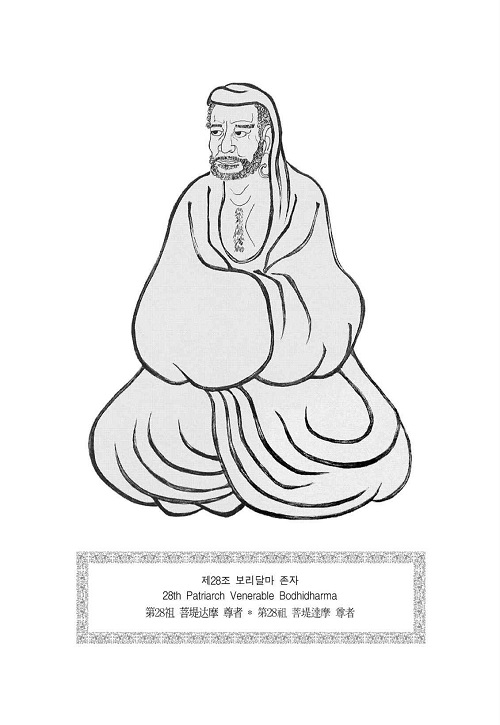
28/1. Bodhidharma; 菩提達磨 Puti Damo (?-532)
보제달마 Boje Dalma
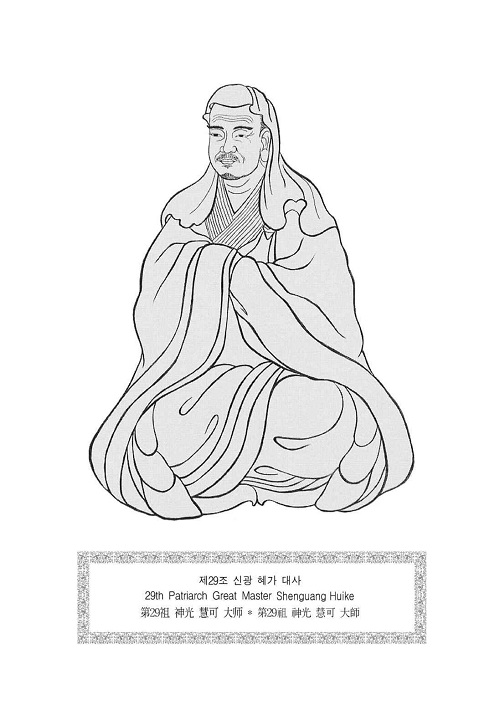
29/2. 大祖慧可 Dazu Huike (487-592)
대조혜가 Daejo Hyega
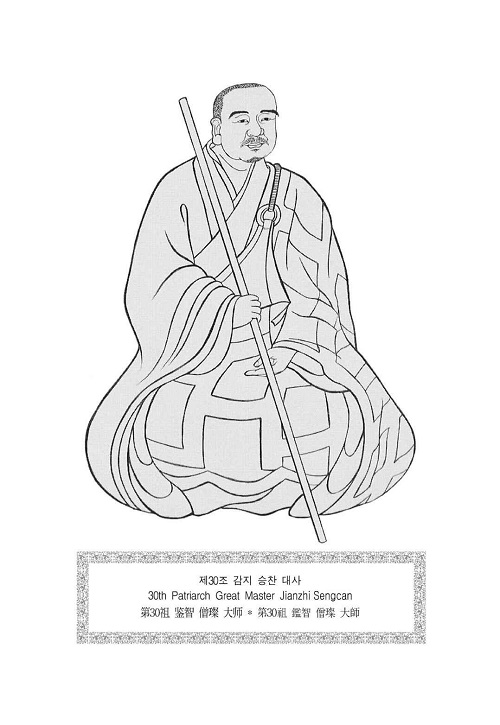
30/3. 江西僧璨 Jiangxi Sengcan (?-606)
강서승찬 Gangseo Seungchan
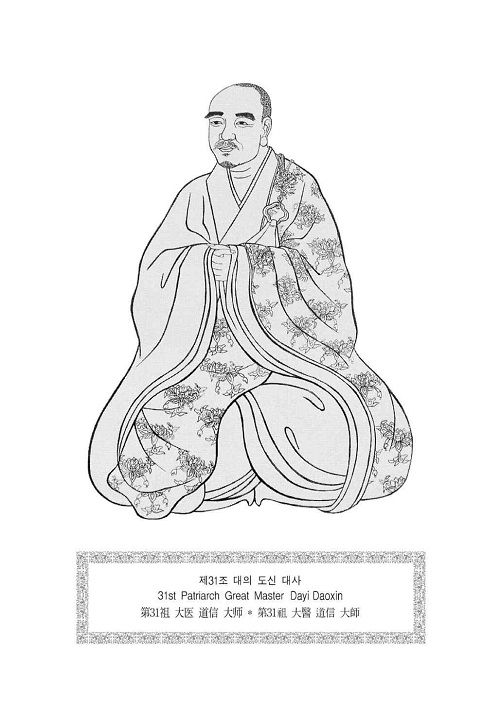
31/4. 大義道信 Dayi Daoxin (580-651)
대의도신 Daeui Dosin
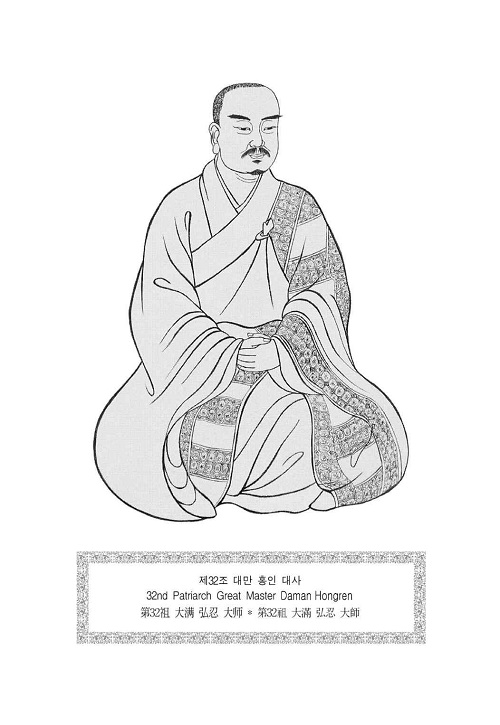
32/5. 道門弘忍 Daomen Hongren (602-675)
도문홍인 Domun Hongin
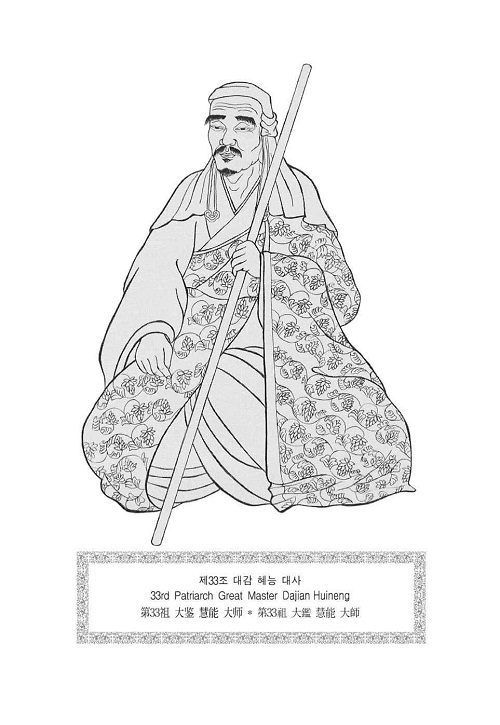
33/6. 大江慧能 Dajiang Huineng (683-713)
대강혜능 Daegang Hyeneung
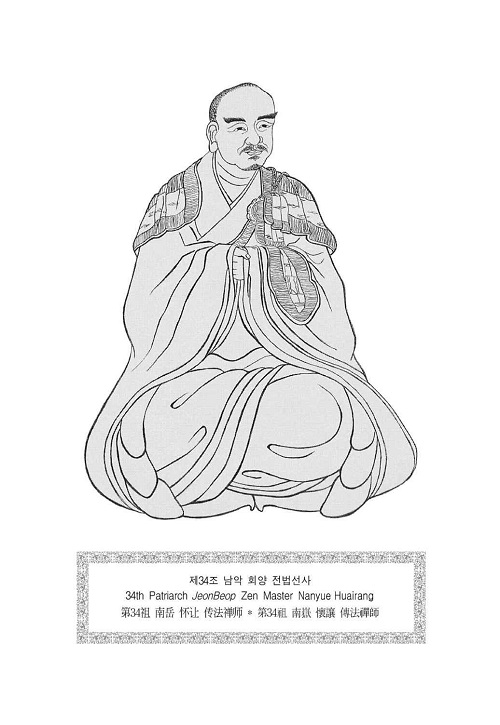
34/7. 南 跃懷讓 Nanyue Huairang (677-744)
남악회양 Namak Hoeyang
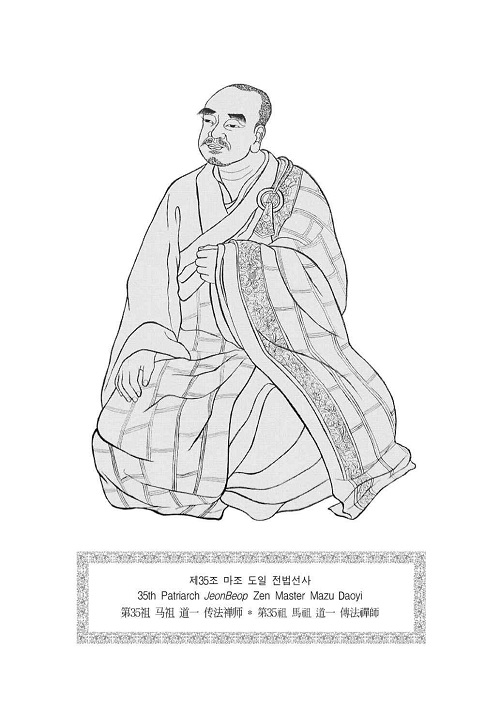
35/8. 馬祖道一 Mazu Daoyi (709-788)
마조도일 Majo Doil
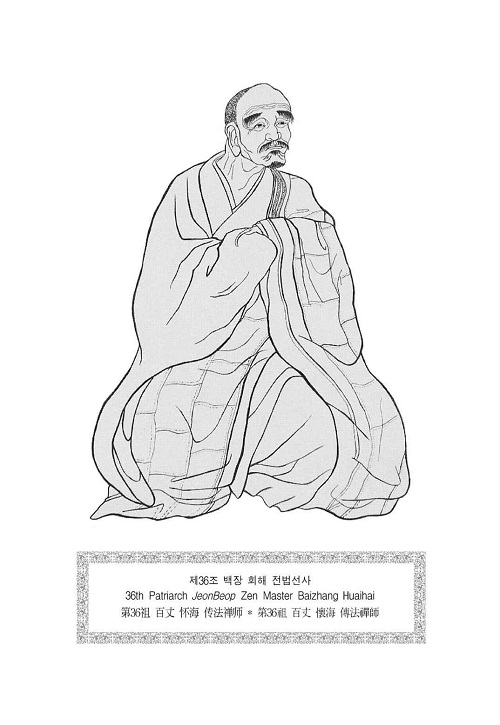
36/9. 百丈懷海 Baichang Huaihai (720-814)
백장회해 Baekjang Hoehae
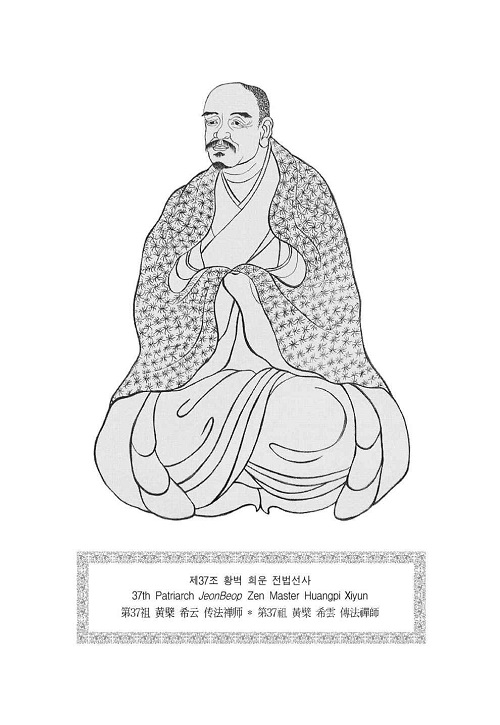
37/10. 黄蘗希運 Huangbo Xiyun (720-850)
황벽희운 Hwangbyeok Huiun
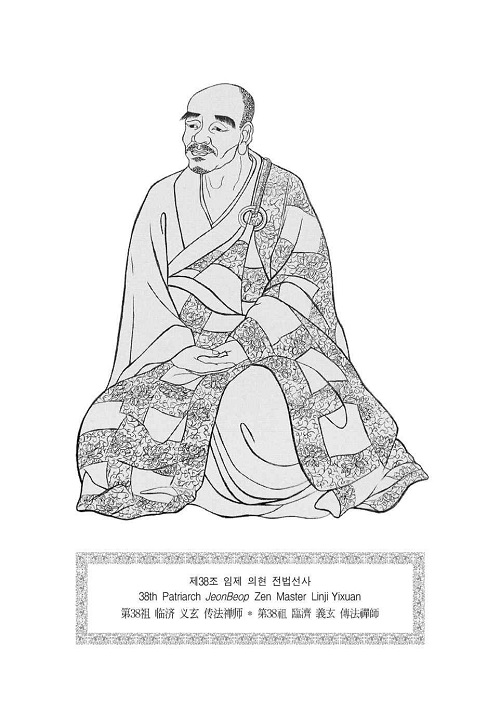
38/11. 臨濟義玄 Linji Yixuan (?-867)
임제의현 Imje Uihyeon
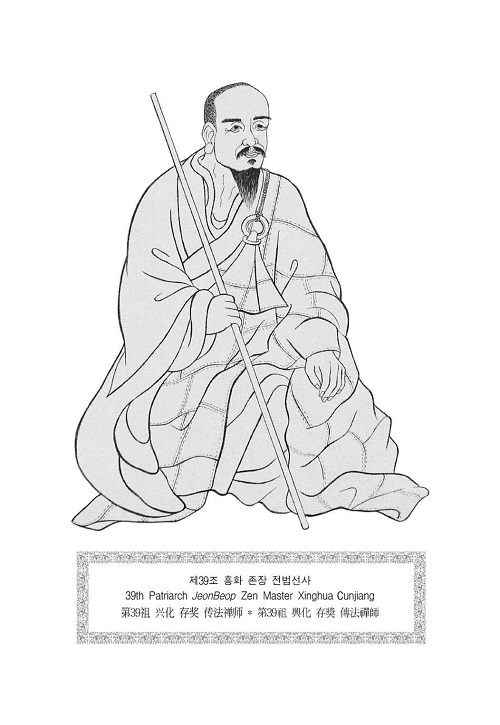
39/12. 興化存奬 Xinghua Cunjiang (830-888)
흥화존장 Heunghwa Jonjang
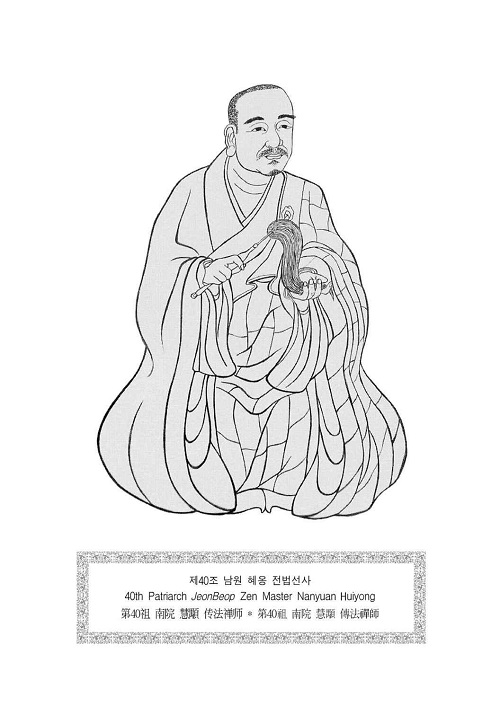
40/13. 南院慧顒 Nanyuan Huiyong (860-930)
남원도옹 Namwon Doong
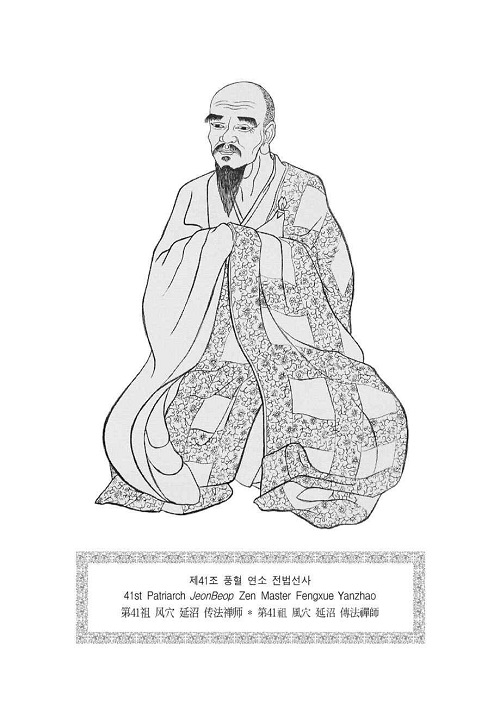
41/14. 風穴延沼 Fengxue Yanzhao (896-973)
풍혈연소 Punghyeol Yeonso
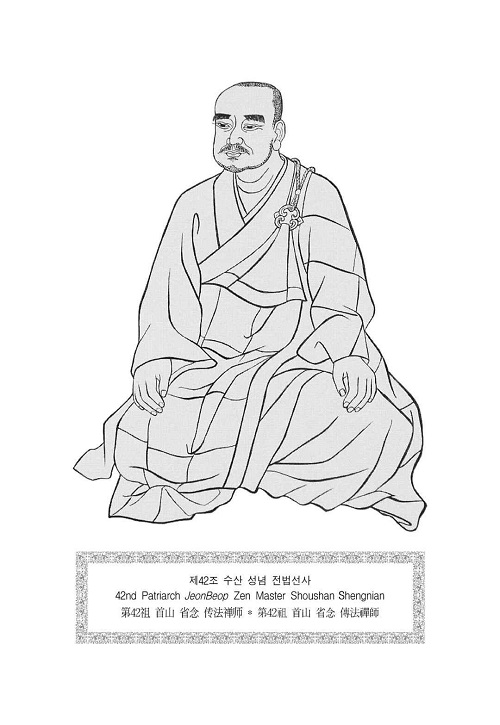
42/15. 首山省念 Shoushan Shengnian (926-993)
수산성념 Susan Seongnyeom
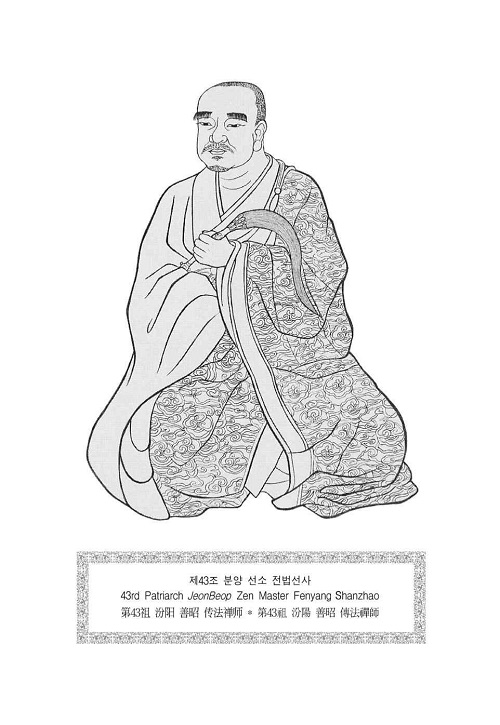
43/16. 汾陽善昭 Fenyang Shanzhao (947-1024)
분양선소 Bunyang Seonso
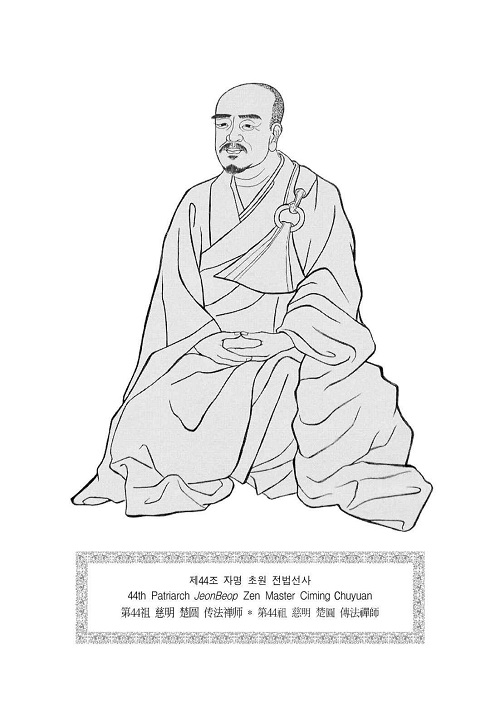
44/17. 石霜楚圓 Shishuang Chuyuan (987-1040)
자명초원 Jamyeong Chowon
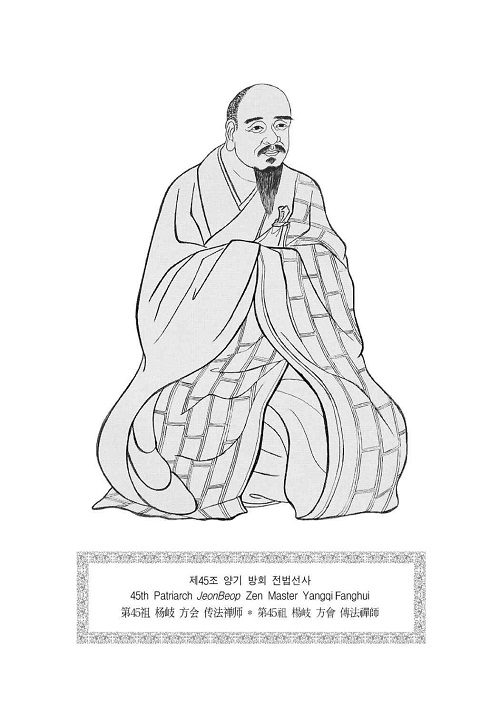
45/18. 楊岐方會 Yangqi Fanghui (993-1046)
양기방회 Yanggi Banghoe
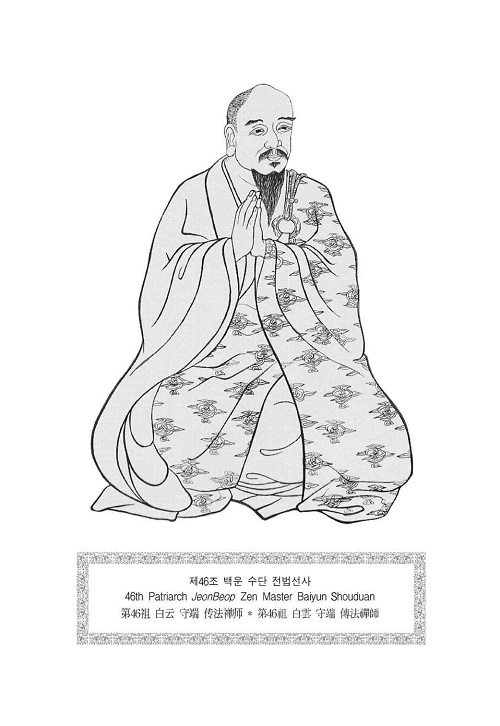
46/19. 白雲守端 Baiyun Shouduan (1025–1072)
백운수단 Baegun Sudan
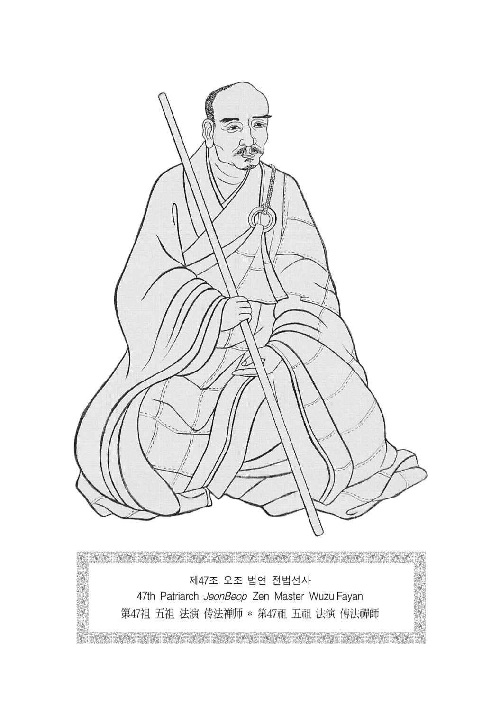
47/20. 五祖法演 Wuzu Fayan (?-1104)
오조법연 Ojo Beobyeon
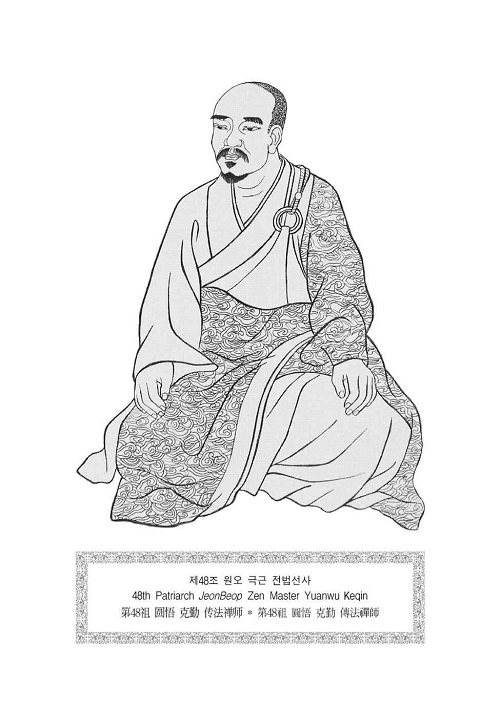
48/21. 圓悟克勤 Yuanwu Keqin (1063-1135)
원오극근 Wono Geukgeun
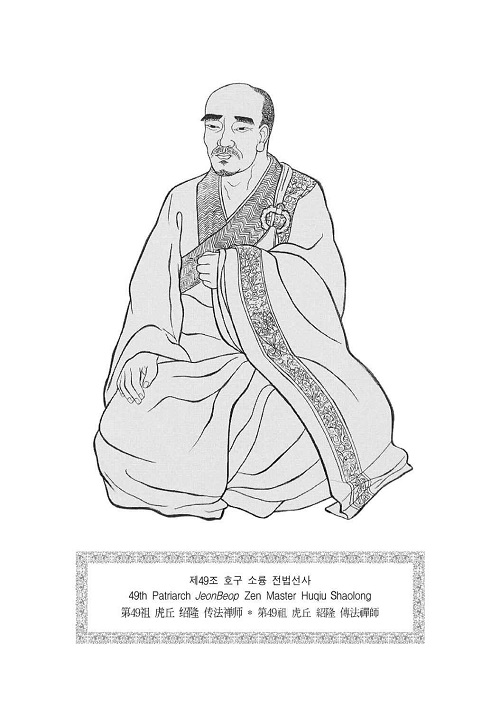
49/22. 虎丘紹隆 Huqiu Shaolong (1077-1136)
호구소융 Hogu Soyung
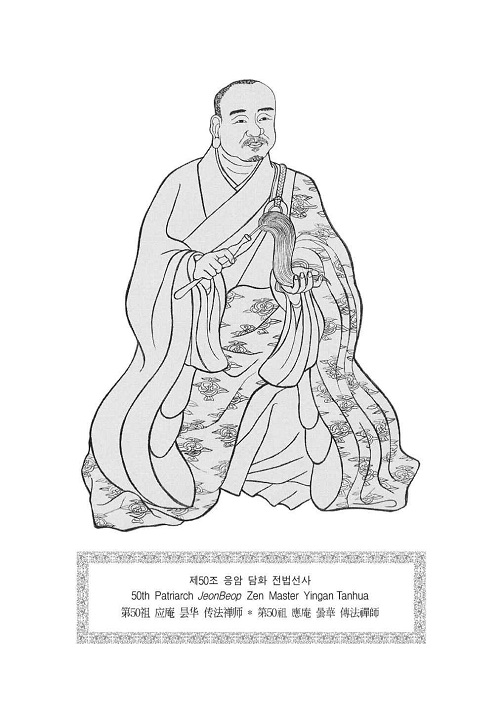
50/23. 應庵曇華 Yingan Tanhua (1103-1163)
응암담화 Eungam Damhwa
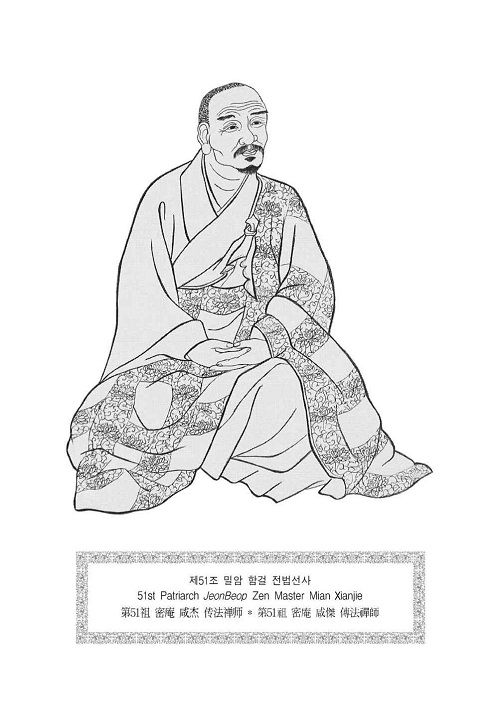
51/24. 密庵咸傑 Mian Xianjie (1118-1186)
밀암함걸 Miram Hamgeol
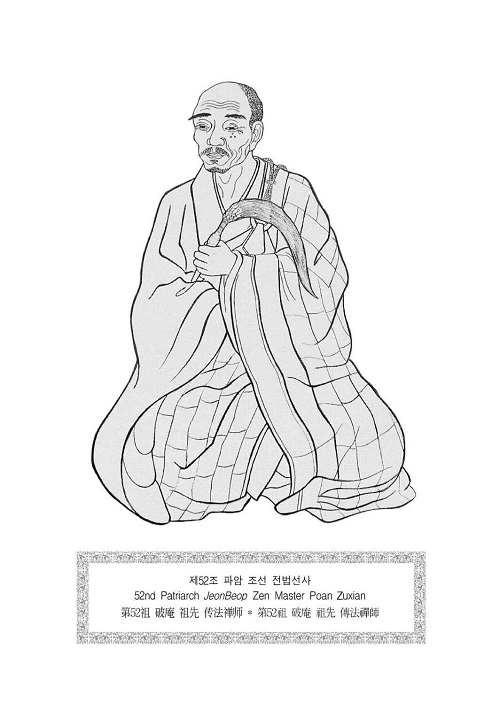
52/25. 破庵祖先 Poan Zuxian ( 1136-1211)
파암조선 Paam Joseon
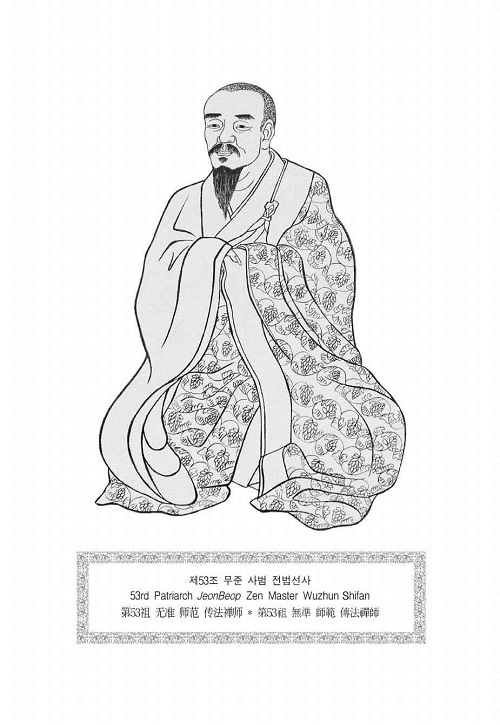
53/26. 無準師範 Wuzhun Shifan (1177-1249)
무준원조 Mujun Wonjo
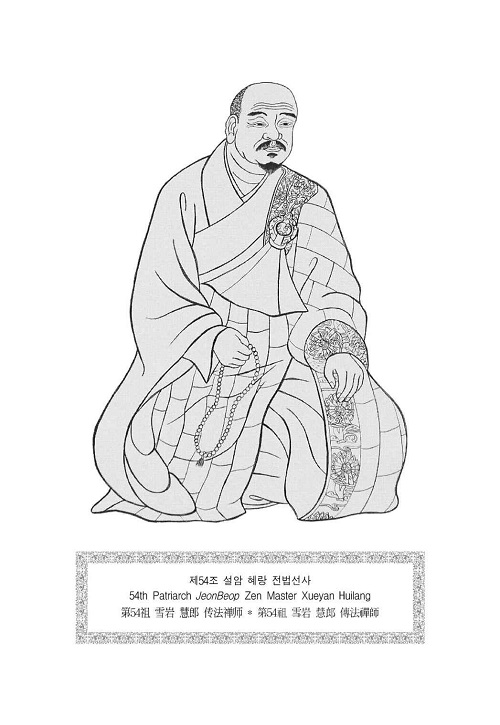
54/27. 雪巖惠朗 Xueyan Huilang (n.d.)
설암혜랑 Seoram Hyerang
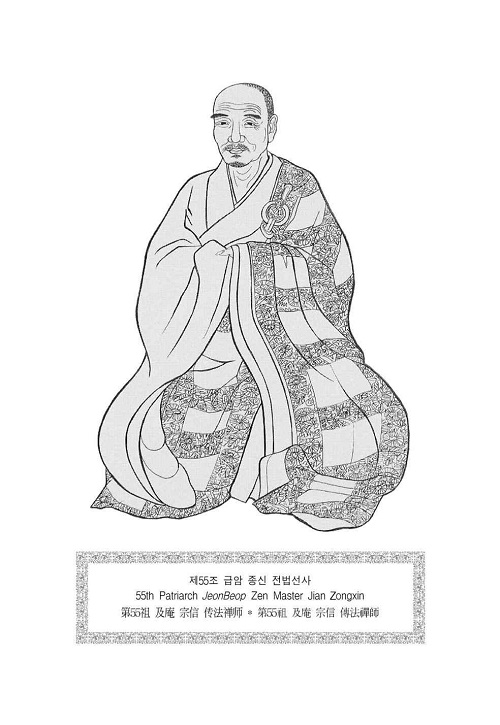
55/28. 及庵宗信 Jian Zongxin (n.d.)
급암종신 Geubam Jongsin
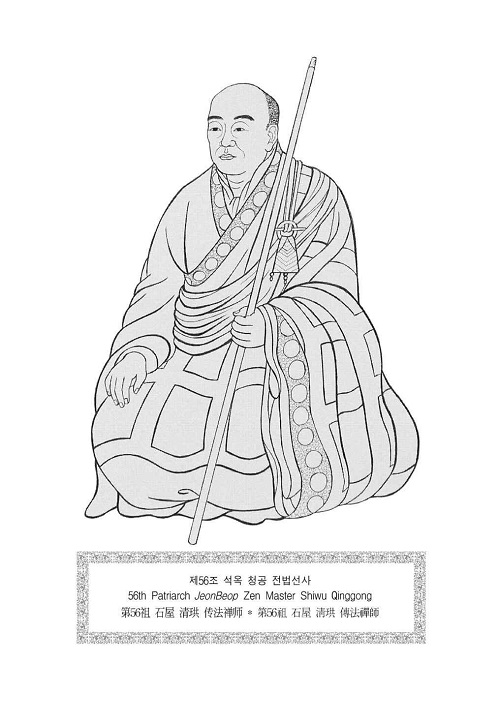
56/29. 石屋淸珙 Shiwu Qinggong (1270-1352)
석옥청공 Seogok Cheonggong
韓國祖師 Korean Patriarchs
Portrait artist: Bhikkhuni Ilseon Na SeongEun
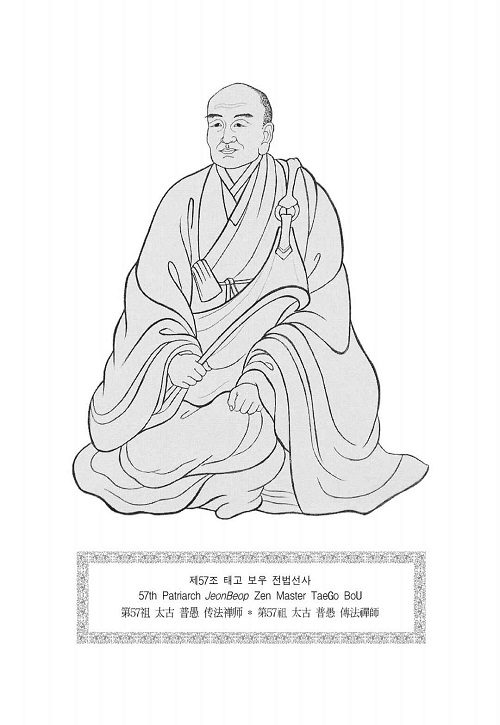
57/30/1. 태고보우 / 太古普愚 Taego Bou (1301-1382)
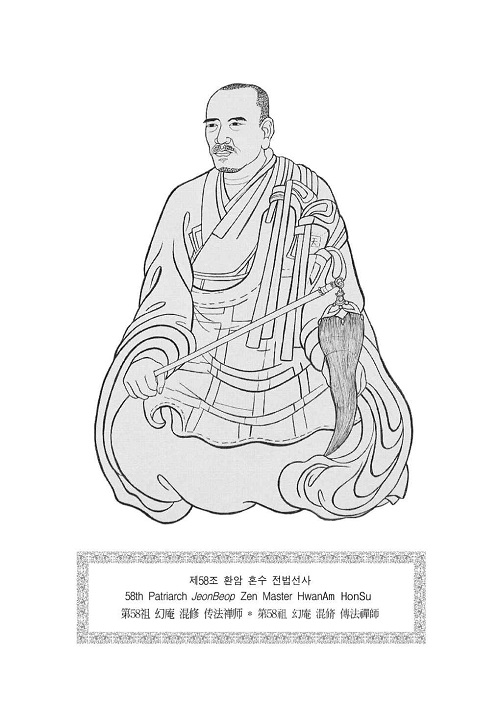
58/31/2. 환암혼수 / 幻庵混修 Hwanam Honsu (1320-1392)
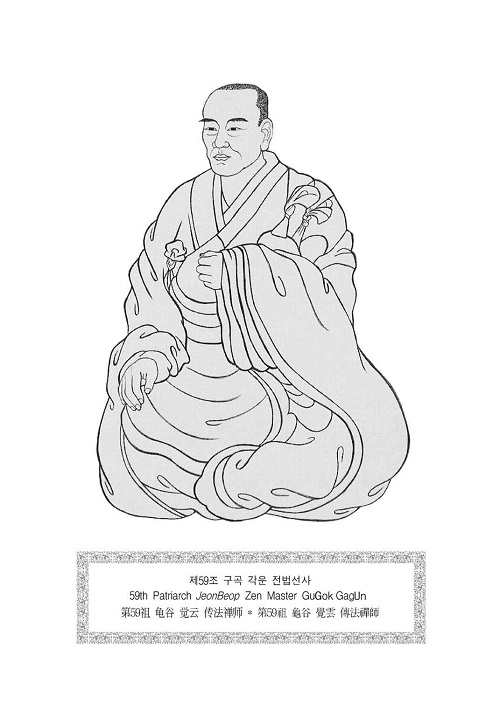
59/32/3. 구곡각운 / 龜谷覺雲 Gugok Gakun (n.d.)
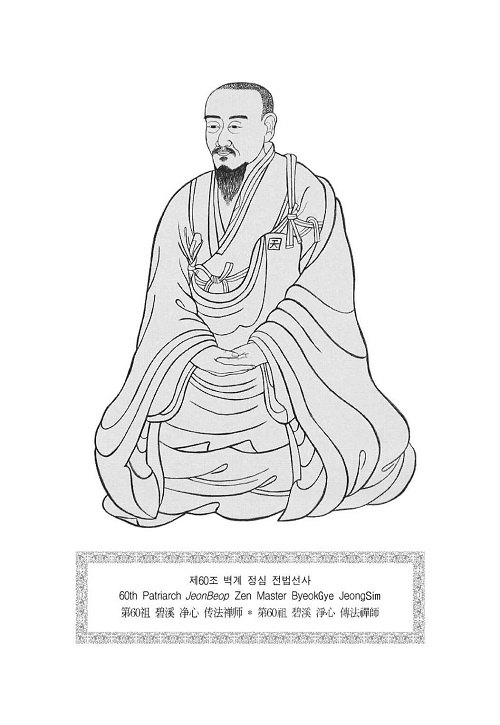
60/33/4. 벽계정심 / 碧溪淨心 Byeokgye Jeongsim (?-1492)
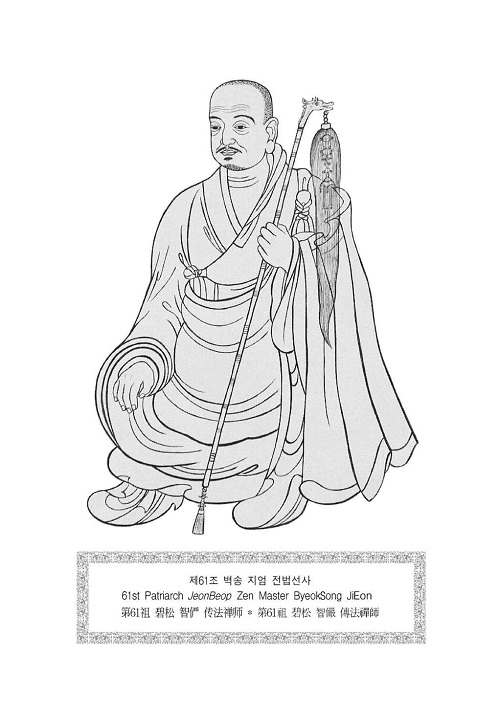
61/34/5. 벽송지엄 / 碧松智嚴 Byeoksong Jieom (1464-1534)
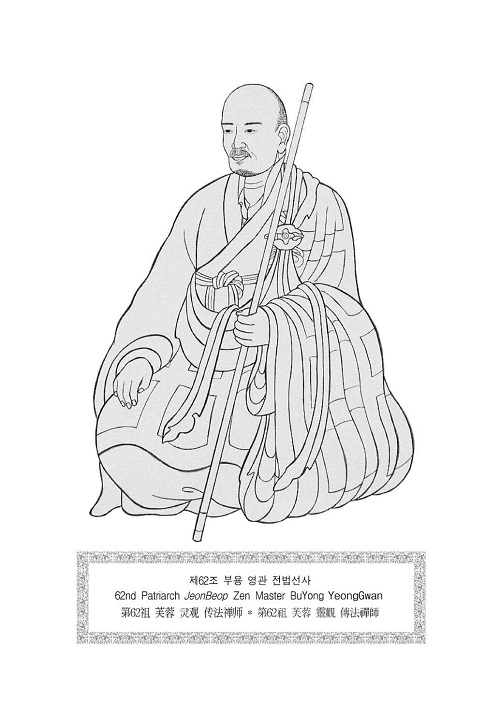
62/35/6. 부용영관 / 芙蓉靈觀 Buyong Yeonggwan (1485-1567/71)
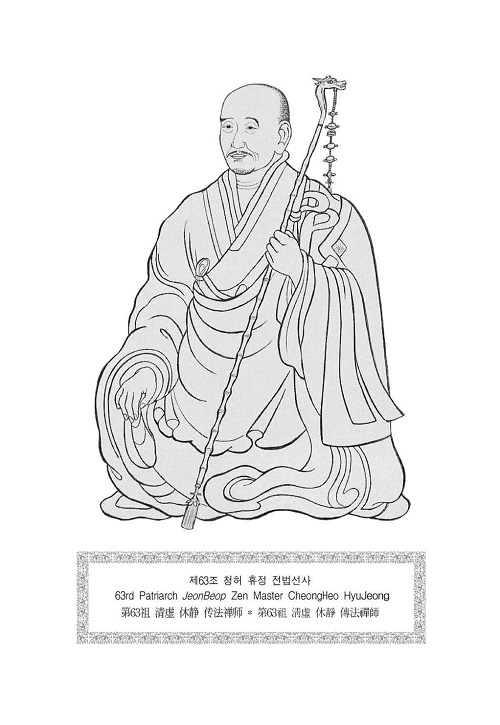
63/36/7. 청허휴정 / 淸虛休靜 Cheongheo Hyujeong (1520-1604)
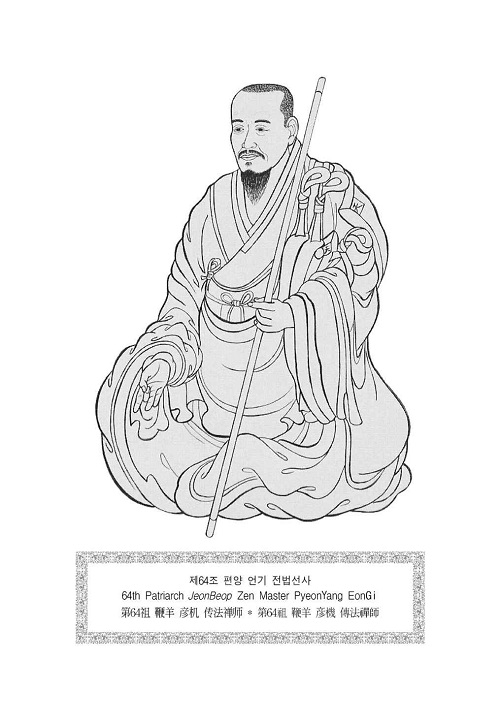
64/37/8. 편양언기 / 鞭羊彦機 Pyeonyang Eon-gi (1581-1644)
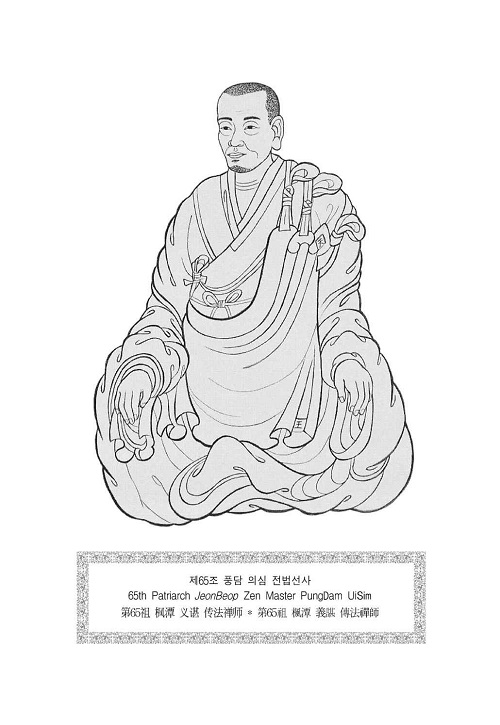
65/38/9. 풍담의심 / 楓潭義諶 Pungdam Euisim (1592-1665)
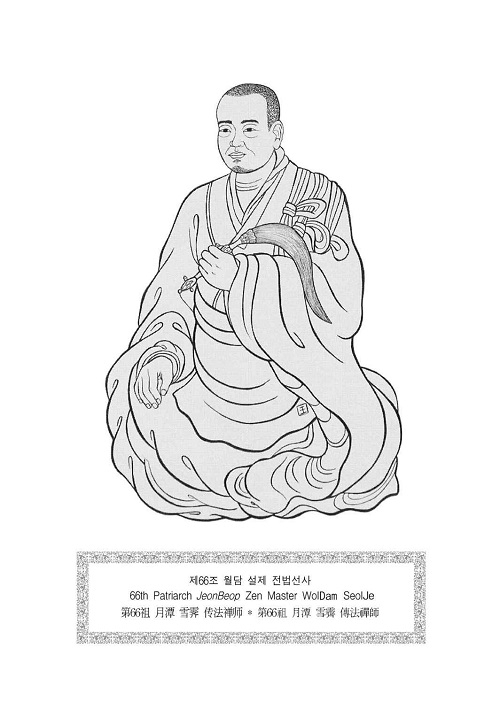
66/39/10. 월담설제 / 月潭雪霽 Woldam Seolje (1632-1704)
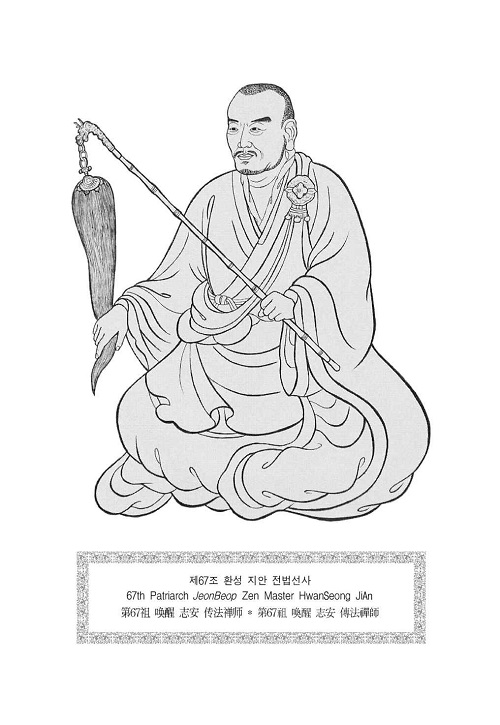
67/40/11. 환성지안 / 喚惺志安 Hwanseong Jian (1664-1729)
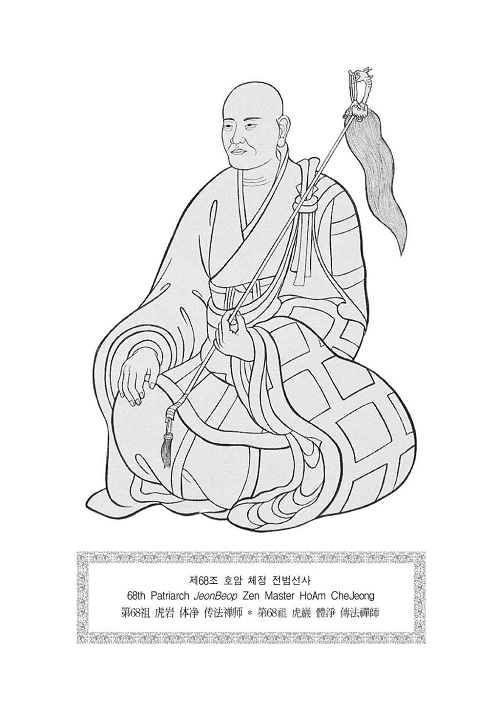
68/41/12. 호암체정 / 虎巖體淨 Hoam Chejeong (1687-1748)
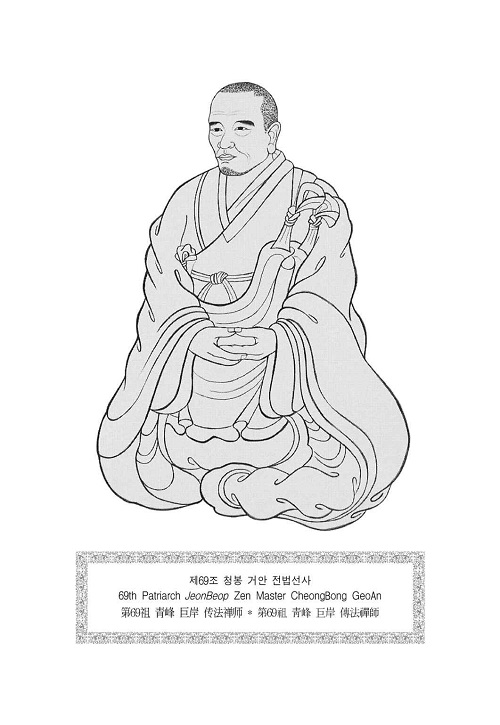
69/42/13. 청봉거안 / 靑峰巨岸 Cheongbong Geoan (1710-1793)
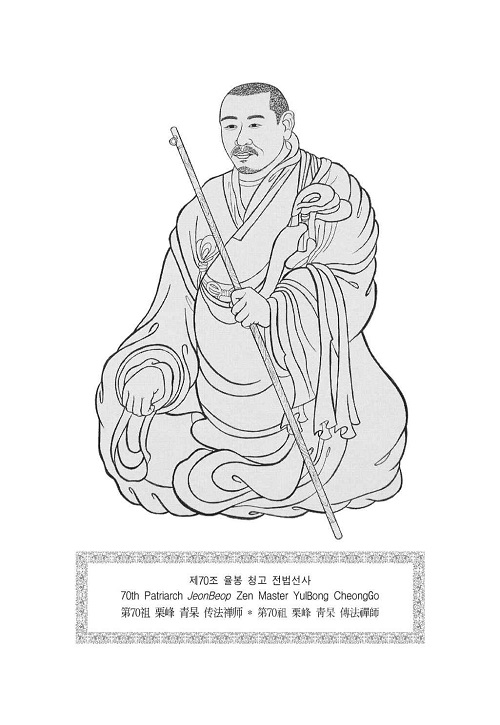
70/43/14. 율봉청고 / 栗峰靑古 Yulbong Cheonggo (n.d.)
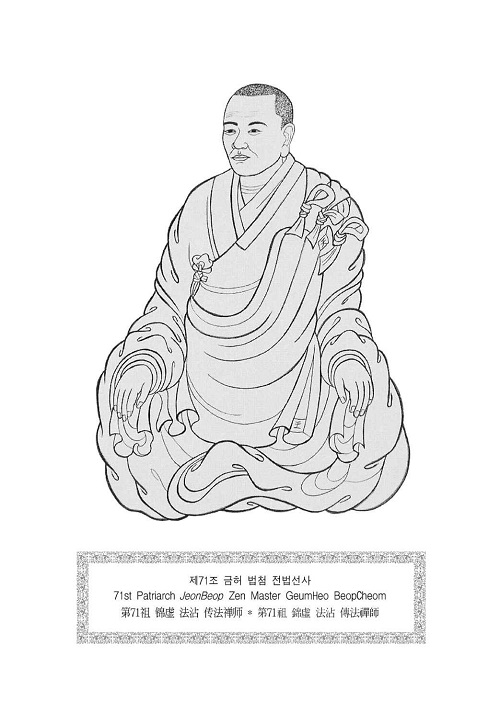
71/44/15. 금허 법첨 / 錦虛法沾 Geumheo Beopcheom (n.d.)
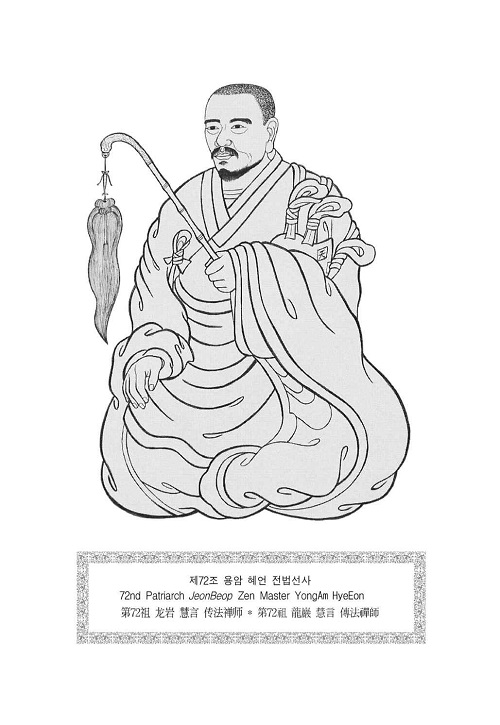
72/45/16. 용암혜언 / 龍岩慧彦 Yongam Hyeeon (n.d.)
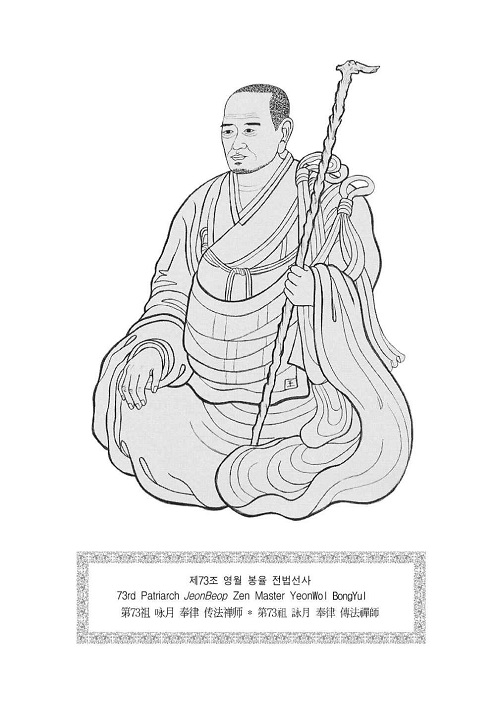
73/46/17. 영월봉율 / 永月奉律 Yeongwol Bongyul (1738-1823)
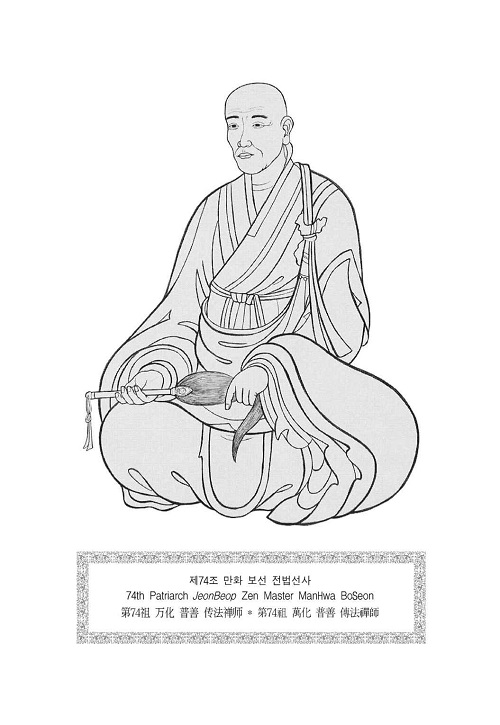
74/47/18. 만화보선 / 萬化普善 Manhwa Boseon (n.d.)
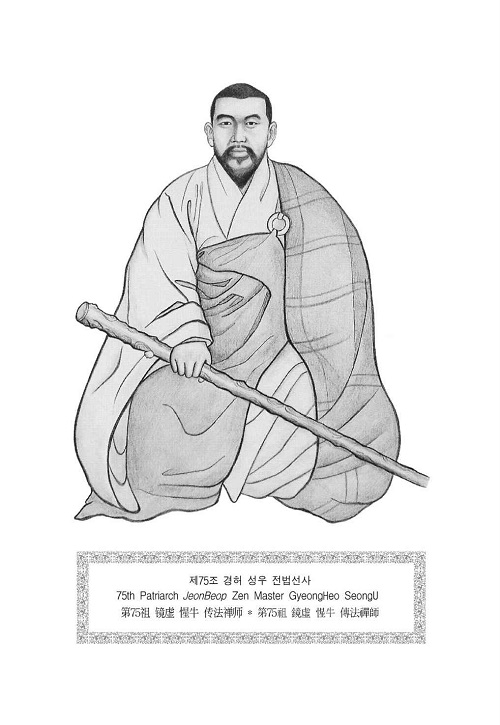
75/48/19. 경허성우 / 鏡虛惺牛 Gyeongheo Seongu (1849-1912)
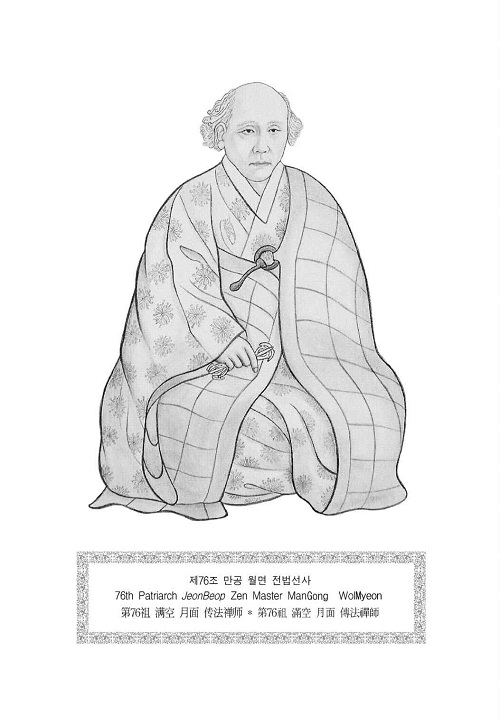
76/49/20. 만공월면 / 滿空月面 Mangong Wolmyeon (1871-1946)
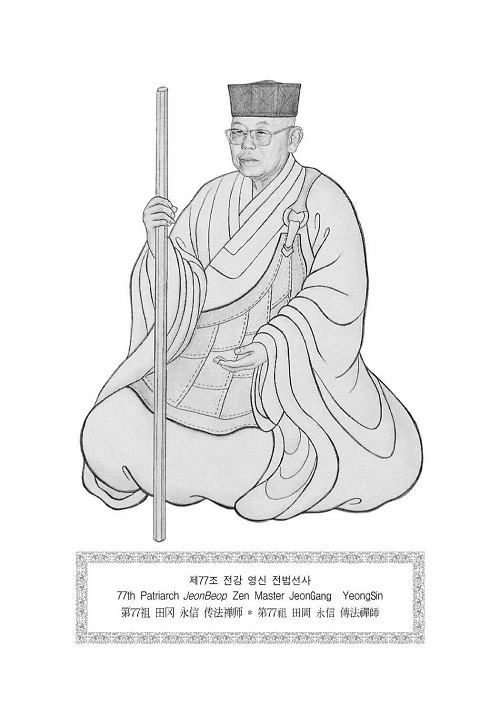
77/50/21. 전강영신대 / 田岡永信大 Jeongang Yeongshin (1898-1975)
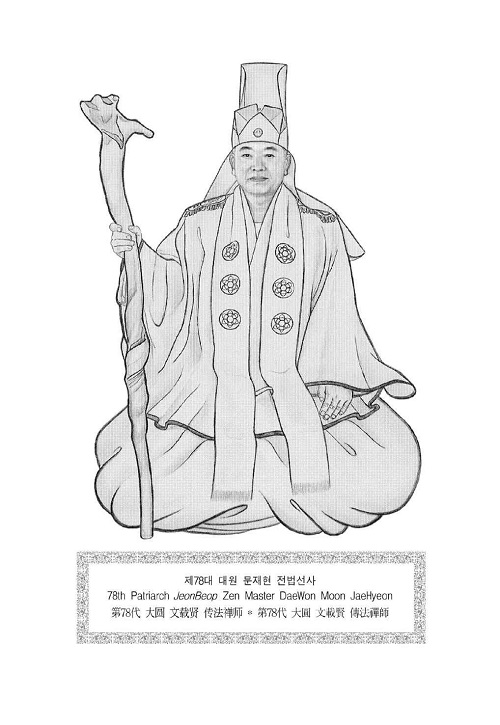
78/51/22. 대원문재현 / 大圓文載賢 Daewon Moon Jaehyeon (1936-)